#mid 16th century B.C.
Text
New Seven Wonders of the World

Great Wall of China (China)
Built between the 5th century B.C. and the 16th century, the Great Wall of China is a stone-and-earth fortification created to protect the borders of the Chinese Empire from invading Mongols. The Great Wall is actually a succession of multiple walls spanning approximately 4,000 miles, making it the world's longest manmade structure.
Christ the Redeemer Statue (Rio de Janeiro)

Sam Valadi via Flickr Creative Commons BY-NC-ND 2.0
The Art Deco-style Christ the Redeemer statue has been looming over the Brazilians from upon Corcovado mountain in an awe-inspiring state of eternal blessing since 1931. The 130-foot reinforced concrete-and-soapstone statue was designed by Heitor da Silva Costa and cost approximately $250,000 to build - much of the money was raised through donations. The statue has become an easily recognized icon for Rio and Brazil.
Machu Picchu (Peru)

Bruce Tuten via Flickr Creative Commons BY-NC-ND 2.0
Machu Picchu, an Incan city of sparkling granite precariously perched between 2 towering Andean peaks, is thought by scholars to have been a sacred archaeological center for the nearby Incan capital of Cusco. Built at the peak of the Incan Empire in the mid-1400s, this mountain citadel was later abandoned by the Incas. The site remained unknown except to locals until 1911, when it was rediscovered by archaeologist Hiram Bingham. The site can only be reached by foot, train or helicopter; most visitors visit by train from nearby Cusco.
Chichen Itza (Yucatan Peninsula, Mexico)

Pavel via Flickr Creative Commons BY-NC-ND 2.0
The genius and adaptability of Mayan culture can be seen in the splendid ruins of Chichen Itza. This powerful city, a trading center for cloth, slaves, honey and salt, flourished from approximately 800 to 1200, and acted as the political and economic hub of the Mayan civilization. The most familiar ruin at the site is El Caracol, a sophisticated astronomical observatory
The Roman Colosseum (Rome)
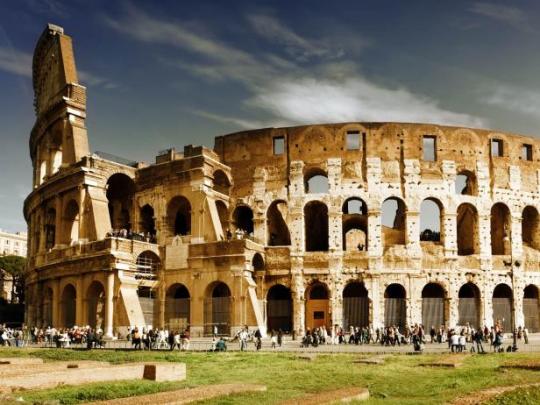
Sam Valadi via Flickr Creative Commons BY-NC-ND 2.0
Rome's, if not Italy's, most enduring icon is undoubtedly its Colosseum. Built between A.D. 70 and 80 A.D., it was in use for some 500 years. The elliptical structure sat nearly 50,000 spectators, who gathered to watch the gladiatorial events as well as other public spectacles, including battle reenactments, animal hunts and executions. Earthquakes and stone-robbers have left the Colosseum in a state of ruin, but portions of the structure remain open to tourists, and its design still influences the construction of modern-day amphitheaters, some 2,000 years later.
Taj Mahal (Agra, India)

Brandon Price via Flickr Creative Commons BY-NC-ND 2.0
A mausoleum commissioned for the wife of Mughal Emperor Shah Jahan, the Taj Mahal was built between 1632 and 1648. Considered the most perfect specimen of Muslim art in India, the white marble structure actually represents a number of architectural styles, including Persian, Islamic, Turkish and Indian. The Taj Mahal also encompasses formal gardens of raised pathways, sunken flower beds and a linear reflecting po
Petra (Jordan)

Dennis Jarvis via Flickr Creative Commons BY-NC-ND 2.0
Declared a World Heritage Site in 1985, Petra was the capital of the Nabataean empire of King Aretas IV, and likely existed in its prime from 9 B.C. to A.D. 40. The members of this civilization proved to be early experts in manipulating water technology, constructing intricate tunnels and water chambers, which helped create an pseudo-oasis. A number of incredible structures carved into stone, a 4,000-seat amphitheater and the El-Deir monastery have also helped the site earn its fame.
3 notes
·
View notes
Note
you can jump anywhere in time where do u go who do u meet and what do u do
Either in Delphi (or some equally extremely cool city) around mid 5th-4th century b.C. to meet Apollo himself (or Dionysus, I guess, if it's winter), or Firenze (or some equally extremely cool place) anytime in between the second half of 15th century and first half of 16th century to meet Leonardo da Vinci and compliment his gaudy velvet pink clothes ((:
#how uncreative of me yeah i know but have you considered that i am a little stuoid in the head#thanks for asking MWUAH!#gin answer#*stupid
2 notes
·
View notes
Text

I opened my sentient dark matter pocket watch and portaled. Algiers Street Oakland March 8th 2:43pm 1962. I was wearing my old 2008 Obama “Hope” sweatshirt. Post-industrial folks don't care what you wear. The 16th and 23rd centuries dangerously different matters. The air was a stew of car exhausts cigarette smoke with background radiations from A-Bomb tests. It was what it was I ain't judging...much. I wandered into a Woolworths.
This being San Francisco it wasn’t segregated. As a lad I got my pencils, and comic books there. Wandered about aisles of mid-century items that in 2024 would be in expensive antique shops. Here it was just the usual dollar store crap.
Saw my treasure. “Fantastic Four” #3. Twelve cents fresh from the printers. I picked up my prize plus some Hershey bars at twice the size, and a first pressing 45rpm copy of the Beatles “I Want to Hold your Hand”. Paid with a 21st century five-dollar bill. I later bought back from Ebay. The Timeline is nothing if not tidy.
Just to make a point. I sat at the Woolworth’s lunch counter. Down South in 1962 doing this might be a death sentence for a Negro. Rogue cops Kluxers everywhere. I ordered hot dog fries, and an orange drink. The main food groups. Tasted as good as I remembered them. Sat watching souls going about their lives. Good eras or harsh 800 B.C. or 2640 folks is folks.
I was in a Woolworths at the height of the American Empire. Told da Klan to bleep themselves had a hot dog and read “Fantastic Four”. What a time we had. I retired to the men’s department. Behind a row of Stetson hats I shifted. Neon shimmer …Poof!
(FB Memory from my Time Portal series.)
0 notes
Photo

How ‘smart poles’ can save energy and enhance smart cities of the future
Although “fixed position lighting” was recorded in Beijing as far back as 500 B.C., and London and Amsterdam introduced public street lighting in the 16th Century, Paris set the example of widespread street lighting. First, King of France, Louis XV, introduced oil lamps into the city in the mid 18th Century; then mass gas lighting was introduced in 1818 followed by electric lighting in 1878[1]. Since then, public street lighting has become an essential infrastructure for every city.
https://blog.nordicsemi.com/getconnected/how-smart-poles-can-save-energy-and-enhance-smart-cities-of-the-future
0 notes
Text

~ Model of a Bird (Substituting for a real offering).
Place of origin: Egypt
Date: mid 16th-mid 11th century B.C.
Period: New Kingdom
Medium: Wood, plaster.
#ancient#ancient sculpture#ancient art#ancient egypt#ancient Egyptian#ancient history#history#archeology#museum#archaeology#Egyptian#Egypt#egyptology#new kingdom#mid 16th century B.C.#mid 11th century B.C.#model of a bird#bird
596 notes
·
View notes
Text


Pi Approximation Day – July 22, 2022
Pi or pie, whether you’re a baker or a math whiz, today is your day — Pi Approximation Day on July 22 honors the concept of pi, which is denoted by the Greek letter pi and approximates to 3.14, in the most mathematically-pleasing way. To further make punny jokes out of pi day, many bake pies on the holiday. It’s a great day to appreciate the math concept used so regularly in many calculations, and eat some delicious pie!
History of Pi Approximation Day
Pi has been known for nearly 4000 years in some form or another. Ancient Babylonians used it — approximated to 3.125, to calculate the dimensions of circles. It was around 250 B.C. that pi was first calculated by one of the greatest ancient mathematicians, Archimedes of Syracuse. He found that pi fell somewhere between 3 1/7 and 3 10/71. Pi is occasionally referred to as the ‘Archimedes’ Constant.’Later, in the mid-400s, another brilliant mathematician, Zu Chongzhi, computed pi again with lengthy calculations. Since Archimedes’ books were lost, and not in China at that time, Zu calculated pi himself in a novel way. Between Zu and Archimedes, these two scientists were the first to know pi in any true sense.Later, mathematicians attempted to better approximate pi using circumscribed and inscribed polygons. This was how Archimedes first solved for pi, and it remained the dominant algorithm for pi computation for 1,000 years. The most correct approximation achieved using this method came in 1630, with Austrian astronomer Christoph Grienberger, who arrived at 38 correct digits of pi.With the development of the infinite series (the sum of the terms of an infinite sequence) in the 16th- and 17th centuries, the way pi was calculated was revolutionized. In India, they discovered it early, between 1400 and 1500 A.D., yet it’s European mathematicians like Leibniz and Gregory who popularized it a century later. Though pi was a well-known concept for centuries, it wasn’t until 1706 that the Greek symbol pi came to represent it. This was suggested by William Jones, a Welsh mathematician, but not popularized until it was used by Leonhard Euler in 1737.In modern times, endless amounts of computing power have been dedicated to approximating the infinite, irrational number to the fullest extent possible. The first time pi was computed by a machine was in 1957, when George Reitwiesner and John von Neumann used an ENIAC computer to compute 2,037 digits of pi. Many intrepid mathematicians followed. By 1973, a million digits were reached with this method.The calculation of pi became a useful stress test for a computer’s abilities — almost like a test for the heart. Mathematicians also hoped to have more accurate calculations for pi for cosmology, though, for most pursuits, few digits are needed. Emma Haruka Iwao, a Google employee who calculated more digits of pi than anyone else to this point — 31 trillion, has earned a place in the Guinness Book of World Records.
https://nationaltoday.com/pi-approximation-day/
4 notes
·
View notes
Text
The Bankruptcy Barrel: A Historical Debate

In recent years I’ve been keeping an unofficial list of once-commonplace iconic images and tropes that seem to have vanished completely from the culture. A man on stilts, for instance, who was usually dressed like Uncle Sam. I can’t remember the last time I saw a man on stilts, or even heard a reference to stilts. Quicksand is another. Time was you couldn’t see a jungle adventure or a wacky comedy that didn’t at some point include a scene in which someone gets stuck in quicksand. For one reason or another, they’re no longer part of our collective consciousness.
Most recently I’ve become a little obsessed with barrel suits (also known as barrel cloaks, barrel shirts, or bankruptcy barrels). You know what I mean—an image of a destitute and naked man, a man who has quite literally and figuratively lost his shirt, who for lack of any other form of clothing has been forced to wear a wooden barrel held up by a pair of attached suspenders. If the subject in question was once very wealthy (i.e. someone who lost everything in the Crash), he might also be seen wearing a top hat. It used to be an inescapable representation of bankruptcy, appearing in countless animated shorts, political cartoons, and comedies.
It seems like such a ridiculous idea if you think about it. There are easier ways to keep oneself covered. A burlap sack, say. A potato sack would be so much easier to craft into a wearable form, and would be more comfortable and practical to boot. With a barrel you need to knock out the bottom, find a way to attach the suspenders, and even after all that’s done it remains impossible to sit down or move very fast while wearing it. There is absolutely nothing practical about a barrel suit. Yet it was the man in the barrel suit who came to immediately signal poverty.
The origins of the image are today a little mirky and the subject of some debate. While most people simply shrug their shoulders as to the origins of the barrel suit, a few intriguing educated guesses have been put forward.
Some trace it back to the 4th century B.C., when Diogenes, founder of the school of Cynical Philosophy, made a virtue of poverty and among his countless other pranks, chose to live in a barrel in the marketplace. It’s a tenuous connection, but perhaps the first historical example of a connection being drawn between poverty, barrels, and cynicism.
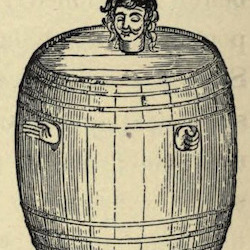
Certain European fairy tales from the 16th century include scenes in which, as punishment, drunkards and gamblers are placed naked into barrels and dragged through the streets behind a horse. Some other sources, apparently inspired by the fairy tales, claim the origin of the barrel suits exclusively the domain of unlucky gamblers. Having lost everything in a game of chance and with nothing left to bet, the other gamblers would place the unlucky man in a barrel and roll him into the street as a form of humiliation. The image of the man wearing a barrel eventually came to represent someone who had, again, lost his shirt while gambling. This notion, however, is mostly the result of armchair speculation.
More readily documented is the fact that in the 18th and 19th centuries, public drunkenness in England and Germany was occasionally punished by forcing the inebriate in question to wear a barrel in the town square, a form of degrading spectacle akin to the more sophisticated stocks.
The barrel as humiliating punishment seems to have made the leap across the Atlantic by the mid-19th century, as revealed in Miles O. Sherrill’s account of being a Union soldier held in a North Carolina prison during the Civil War.
“While we were standing in the snow, hearing the abuse of Major Beal, some poor ragged Confederate prisoners were marched by with what was designated as barrel shirts, with the word "thief” written in large letters pasted on the back of each barrel, and a squad of little drummer boys following beating the drums. The mode of wearing the barrel shirts was to take an ordinary flour barrel, cut a hole through the bottom large enough for the head to go through, with arm-holes on the right and left, through which the arms were to be placed. This was put on the poor fellow, resting on his shoulders, his head and arms coming through as indicated above; thus they were made to march around for so many hours and so many days.“

And while the connection remains a little fuzzy, that, perhaps, might lead to the next and final jump. The origins of the barrel suit as a symbol of poverty are today generally traced back to Will B. Johnstone. In the 1920s and ‘30s, along with being a successful song lyricist (best known for “How Dry I Am”) and a writer for the Marx Brothers, Johnstone was also a popular political cartoonist for the New York World-Telegram. Among the regular cast of symbolic characters who appeared in his panel was The Taxpayer (the date of his debut is unknown), a naked man wearing a barrel to illustrate his penniless state. With the Great Depression, it’s not hard to see how The Taxpayer may have come more generally to represent the millions who had lost everything.
But even if that answers the question of where the symbol as we know it first appeared, there is another angle to this whole debate. Several, actually. Some who’ve written on the subject claim the barrels being used as clothing for the poor were almost exclusively pickle barrels, whereas beer and whiskey barrels were used to punish drunks and, as noted above, confederate thieves were made to don flour barrels. And if in fact pickle barrels were reserved for the destitute, it might be read that someone in dire straits has found himself, yes, in a pickle.
Of course there is an easier and less product-specific answer to the question of why barrels were chosen as the adopted mode of dress. Today it’s become cliche to think of the homeless living in cardboard boxes. The reason is simple—cardboard boxes are plentiful and easy to come by. By the same token in the early part of the 20th century everything was shipped in barrels making them just as readily available as cardboard boxes are today. Maybe it only makes sense that something of that size and shape that was at the same time so ubiquitous and cheap might come to be seen as a potential clothing substitute when nothing else was available.
Still, though, why dress the downtrodden in barrels instead of the much more logical and functional burlap sack? From a cartoonist’s perspective, it’s an even simpler answer. Keeping in mind that during the Depression the nation’s poor did not actually dress in barrels save for comedies and cartoons, barrels were easier to draw, they were more immediately recognizable in a cartoon panel than a burlap sack would have been, and most important of all, they were funnier.
by Jim Knipfel
9 notes
·
View notes
Text
Week 4: Stock and Soups I
Introduction
This week, I will be learning...
Method: Dicing vegetables, peeling tomatoes, cooking pasta
Menu: Minestrone Soup, Vegetable stock, Beef Stock
Vocabulary: Mirepoix, broth, stock, concasse, sachet, bouquet garni, remouillage, glace/glaze
What I Know So Far (not a ton)
I know that the flavor of the stock is affected by the quality of my ingredients, how those ingredients are combined, and the cook time. I am sure that there are other factors too. Stocks are added to soups to provide either a base flavor or an additional layer to the soup flavor. I know that stock can be condensed to form a thick flavorful syrup or hard pieces (portable soup), and that the condensed stock can be rehydrated on its own with water or added to something else, such as to a sauce. Stocks have no solid components.
Learning Objectives
My learning objectives are to be able to list the different cuts of vegetables, articulate the principles of making stock, prepare a vegetable stock, understand the different classifications of soup, produce a broth soup, and practice the costing of menu items.
Research
Method of Cooking
Stocks are entirely liquid, and the time a stock spends simmering depends on what it is being flavored with, with beef bone stocks taking the longest. They can take ten hours of simmering before they are ready, while a fish based stock may become overcooked and sour in less than forty-five minutes. Fish and vegetable stocks are popular because 1) fish and vegetables can make a stock in much less than an hour, 2) the stocks can be made with pieces that would ordinarily be wasted, so it is economical. Beef stock is an amazing use of beef bones because they make sure less of the animal is wasted. When boiling the bones, the goal is to extract as much flavor and fat as possible. The sign of a good beef stock is gelatinization.
When making a stock, salt is not added until the stock is used in a dish. This is to protect the flavor. A bouquet garni is an assortment of vegetation, usually tied with twine, that goes into the pot to infuse flavor. A sachet has the same goal, however because it is tied in a cheese cloth, it can hold smaller items such as peppercorn or bayleaf.
Origin and History
Minestrone is yet another tried and true dish created in Italy. This soup has been around since before the Roman Empire, and has stood the test of time. In 2nd century B.C., meat became more available with the Romans’ increasing road networks. Amazingly enough, this soup was eaten by Roman soldiers and made with common vegetables for most of its history. The effect of this being eaten by people who did not have access to every vegetable at all times was that the recipe varies drastically based on availability. This hot, vegetable-based soup was and is of course eaten year-round, and so it had to be modified seasonally to accommodate vegetables’ growing period. Not only did the recipe change from day-to-day and from season-to-season, it was not until until almost two millennia later that two more ingredients would be included:
“The introduction of tomatoes and potatoes from the Americas in the mid-16th century changed the soup by making available two ingredients which have since become staples (2)”
Quite the unpredictable recipe.
This soup is heartier than other soups because of the beans it contains. The beans are also what separate it from vegetable soup, and pasta is also a signature ingredient. Minestrone has been historically made with pasta, but sometimes rice is added instead, or in conjunction with the pasta. Some examples of pasta are large sized pasta such as maccheroni, ditaloni rigati, or ditaloni lisci (1).
Sources
1)Taste.com.au. (2014, June 5). Using pasta in soup. www.taste.com.au. https://www.taste.com.au/quick-easy/articles/using-pasta-in-soup/kambb0ek
2)Wikimedia Foundation. (2022, January 13). Minestrone. Wikipedia. https://en.wikipedia.org/wiki/Minestrone
Recipes
Minestrone Soup

Vegetable Stock

Brown Stock
Plan of Work

Plate Presentation Models

“Homemade vegetarian minestrone, chunky/country style, containing the following ingredients: extra virgin olive oil, white onion, carrot, courgette, peas, extra fine green beans, savoy cabbage, conchiglie pasta, coarse ground black pepper, table salt, garlic purée, vegetable stock, water, tinned chopped tomatoes, fresh basil, Worcestershire sauce, parmigiana cheese. Garnished with grated parmigiana and a sprig of basil.” Julie Anne Workman. Wikipedia, “Minestrone”. 2011.

“Minestrone Soup”. Jessica, Lindsey, & Rowland, B. (2016, September 8). Minestrone Soup. Sweet Love and Ginger.

Minestrone soup with veggies, beans + tomato-herb flavor. Bernie. A Gouda Life. (2021, November 29).
Results and Reflection
The size of the vegetables worked well for the time we had to cook the dish. Had the size been larger, I believe the stock and subsequent soup would have been less flavorful.
Overall, the strongest flavor in the soup was tomato and carrot. They created a nice interplay between sweet and sour. The onion and garlic made for a nice aroma. I would have preferred to see less oil in the surface. We skimmed some of the residue off, but maybe wiping the rim of the bowl before serving would have done the trick. The picture below is of our minestrone soup and it is taken in a light-box.
The color of our soup is less red than the soups in the example images, however I think it is a nice clarity. In the future, I would use an already bite-sized noodle instead of snapping spaghetti. I would also use more beans in the future to be more filling.
The texture of all of the vegetables was similarly tender, except for the cabbage which still had too much crunch. In the future this issue can be resolved by chiffonading the cabbage more finely and/or putting it in the soup a couple minutes earlier to tenderize it.

Cost Analysis Chart


Conclusions
I believe I excelled at creating tomato concasse. I was able to cut and time the steps accurately to the point where I would be comfortable showing someone else.
I became more familiar with the layout of the kitchen. This will save valuable time in future labs.
I have already used skills I learned in this lab. I made chickpeas this week for part of a meal and I infused the boiling water with vegetable scraps, something that I have not done before. The onion skin and garlic pieces as well as basil stems and peppercorns I added to the water made the chickpeas taste surprisingly more flavorful.
I would love to improve my ability to gauge the amounts I need to cut in order to cut the right weight without creating too little or too much.
References
1)Taste.com.au. (2014, June 5). Using pasta in soup. www.taste.com.au. https://www.taste.com.au/quick-easy/articles/using-pasta-in-soup/kambb0ek
2)Wikimedia Foundation. (2022, January 13). Minestrone. Wikipedia. https://en.wikipedia.org/wiki/Minestrone
1 note
·
View note
Photo


Cameo: early Hellenistic 4th century B.C. / Alexander the Great (?)
Ring: mid-16th century, probably Italian
Turquoise, enamel, gold
The Metropolitan Museum of Art
98 notes
·
View notes
Text
To see the web page which goes with this choose the link [in blue] below.
Seven Emblem books and two others!
Two sort of emblematic books (A&B) and Seven(1-7) emblem books in contemporary or original bindings!
1) Andres Alciati 1492 – 1550
V.C. Emblemata (Viri Clarissimi) Emblemata. Cum Claudij Minois ad eadam Commentariis & Notis Posterioribus. Quibus Emblematum omnium aperta origine, mens auctoris explicatur, & obscura omnia dubiáque illustrantur.
Lugduni (Lyon), Hæred. Gvlielmi Rovilii, 1600. 1600. Bound in coeval vellum with author and title on the spine in an early hand. Octavo ã8, e4, i8 A-Eee8, Eee*2 Fff8 Ggg4.
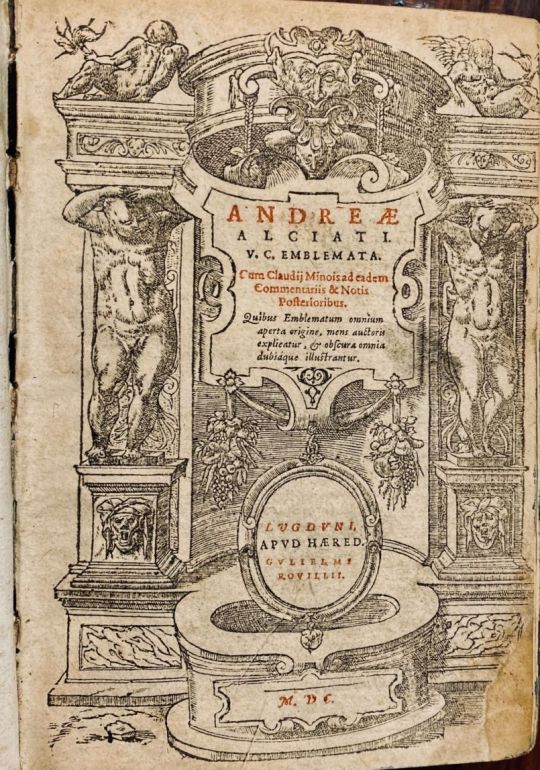
The ultimate reference for this book is Daly’ Andres Alciatus Index Emblematicsus 1985; ; Landwehr, J. Romanic emblem books; 89 ; Adams, A. French emblem books; F.063; Emblem books at the Univ. of Illinois; A32; Green, H. Andrea Alciati and his books of emblems,; 127; Baudrier, 1895-1921, v. 9, p. 464-65;. Item #738G
The emblem book, which attained enormous popularity in continental Europe and Great Britain, while it is possible to trace it back before was certantly made most popular by Alciati. . Alciato’s emblems were first published in Augsburg in Germany (two editions in 1531 and one in 1534); from 1534 onwards publishing shifted to France and remained there for the next thirty years. Wechel, who printed the Paris editions (from 1534), are like those in Augsburg. He can be said to have set the standard for clear presentation of emblems, with each emblem beginning on a fresh page, featuring the motto or title, the pictura below that, and then the subscription/epigram or verse text the main focus of publication for emblems shifted more firmly to Lyons from the mid 1540s, The 1550 Latin edition by Rouille is the first to have 211 emblems (the whole corpus, apart from the so-called obscene emblem ‘Adversus naturam peccantes’) illustrated. This edition includes biography of Andrea Alciati (leaves i1-i8). These emblems depict Alciati’s concern for the eternal nature of man and its contradictions, the attentive ear to the popular speech, the unfolding of the personality, madness, the reflection on human existence, the relationship between man and the woman, the struggle between reason and passion, and to the satire of society and its rules and rulers.
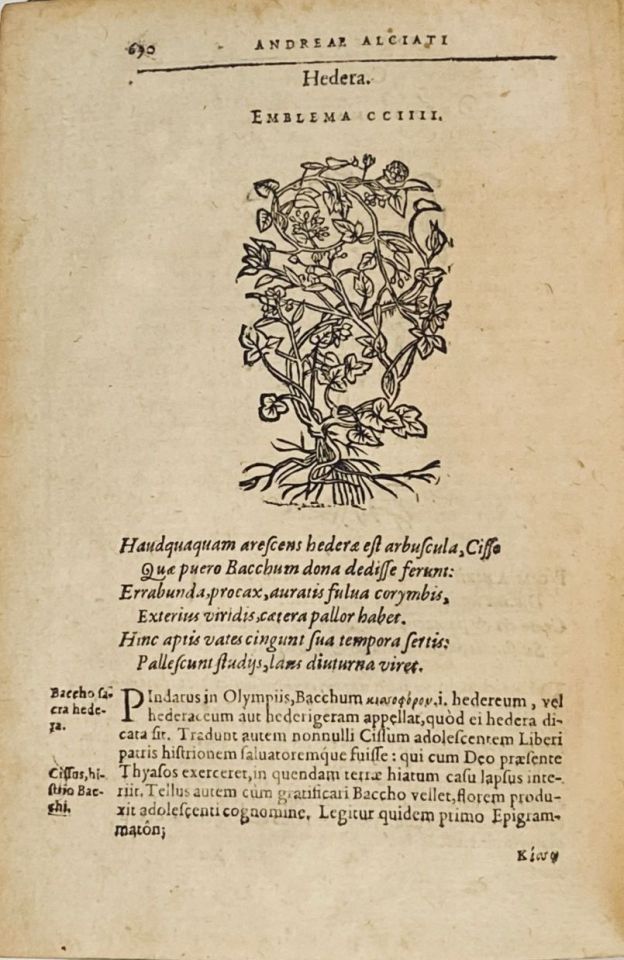
A) CARTARI 343J Vincenso Cartari. 1531–1569
Seconda novissima editione delle Imagini de gli dei delli antichi di Vicenzo Cartari …Ridotte da capo a piedi alle loro reali, & non più per l’adietro osseruate simiglianze. cauate da’marmi, bronzi, medaglie, gioie, & altre memorie antiche; con esquisito studio, & particolare dligenza da Lorenzo Pignoria … Aggionteui le annotationi del medismo sopra tutta l’opera, & vn discorso intorno le deità dell’Indie orientali, & occidentali, con le loro figure tratte da gl’originali, che si conseruano nelle Galleri de’principi, & ne’musei delle persone priuate. Con le allegorie sopra le imagini di Cesare Malfatti … Et vn catalogo di cento più famosi dei della gentilità. Con l’aggiunta d’vn’altro catalogo de gl’autori antichi, & moderni, che hanno trattato questa materia, ordinato & raccolto dal medesimo Pignoria che ha accresciute le annotationi & aggiunte molte imagini.
In Padova, Nella stamparia di Pietro Paolo Tozzi. 1626. Quarto, 9 1/4 x 6 1/2 in 224×162 mm. Signatures: ‡8 ≠≠1,a6, ‡‡4 [∏2 FOLDOUTS] A-Z8 ,AA-OO8 (38 pages, 589 pages illustrations, two folded plates) [[38] pages, 589 pages illustrations, two folded plates 24 cm]. 2 double-page woodcuts and 227 full-page and in-text woodcuts of the ancient gods by Cesare Malfatti. * *. *
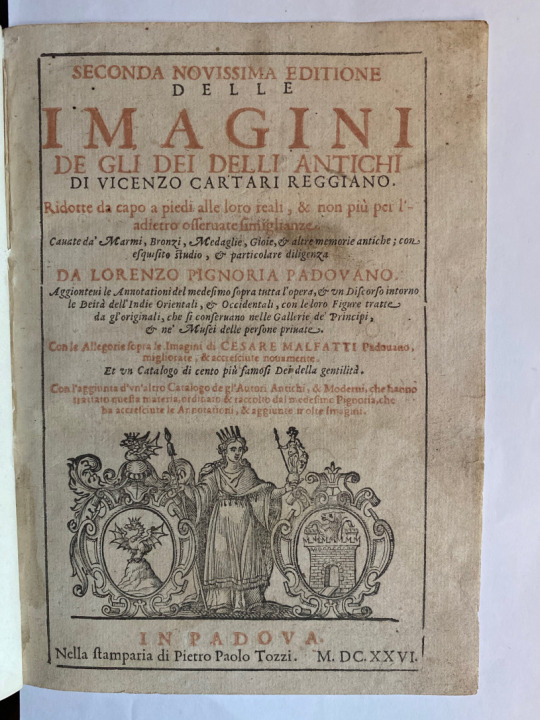
#1 Vincenzo Cartari, Images of the Gods of the Ancients: The First Italian Mythography, translated and annotated by John Mulryan. Medieval and Renaissance Texts and Studies vol. 396. Tempe, AZ: Arizona Center for Medieval and Renaissance Studies, 2012.
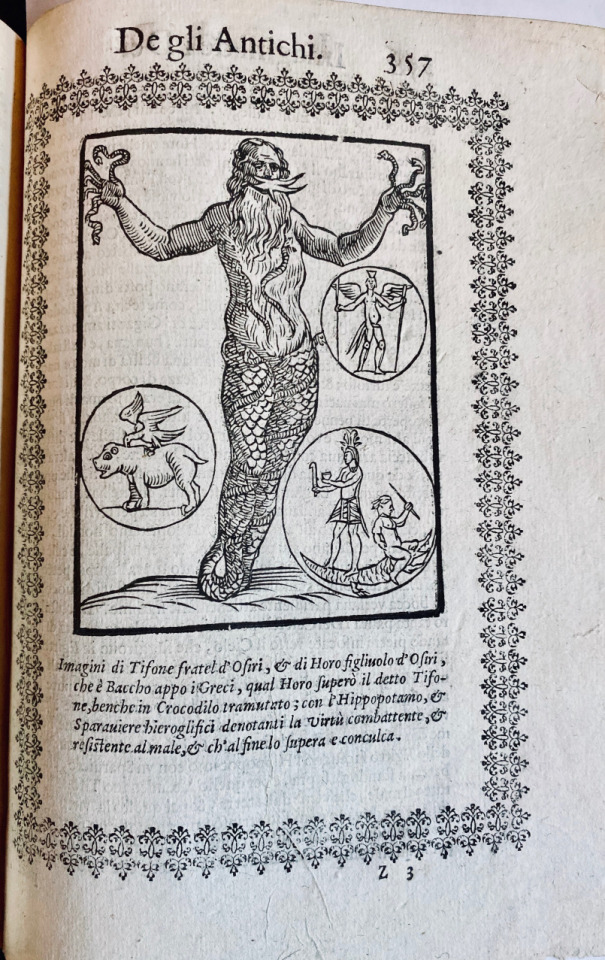
Praz 36; Cicognara 4686; Graesse II.56; Nagler XXII.15, ; Harvard 156.108; JCB Library catalogue; 2:198; Sabin 11104.; BM. STC.(Ital.) 152.; ‘Choix 4280. See Also: Mortimer, Italian, 108 note. Caillet 2047 (French trans.) Brunet I,1601. Graesse II,56.Univ. Cat of Art, 287. Arntzen & Rainwater H35.Dekesel 16th, C11. �� And :
1)Sonia Maffei, ‘Le imagini de i Dei degli antichi di Vincenzo Cartari: Dalla poesia all’archeologia’ http://dinamico2.unibg.it/cartari/leimaginideiDei.html
2) Marco Urdapilleta Muñoz, ‘El bestiario medieval en las crónicas de Indias (siglos XV y XVI)’, Latino América, Revista de Estudios Latinoamericanos, 58 (2014), 237-70. 5160.235500
3) Miguel A. Rojas Mix, América imaginaria (Barcelona, 1992) LB.31.b.10858
4) Rosa López Torrijos, La mitología en la pintura española del Siglo de Oro (Madrid, 1985). YV.1988.b.1010 María Jesús Lacarra, Juan Manuel Cacho Blecua, Lo imaginario en la conquista de América (Zaragoza, 1990). YA.1997.a.7376
5) Mercedes Aguirre at 11:59:11 in Americas , Collections , Latin America , Medieval history , Mexico , Rare books. BL.
6) Mexican Codex Vaticanus 3738. Item #743
This is the First Edition in which the antiquarian and egyptologist who was also interested in the sciences, and a friend of Galileo. Lorenzo Pignoria added his appendix Seconda Parte delle Imagini de gli Dei Indiani displays detailed illustrations of some archeological remains portraying Mexican, Egyptian, Indian and Japanese gods, seeking ‘a sort of unique visual language in pre-Christian religions. It is bound in.
Price: $4,500.00
B). Cuper, Gisbert Cuper. 1644-1716
Gisb. Cuperi Harpocrates, Sive Explicatio imaguncluæ argenteæ perantiquæ; quæ in figuram Harpocratis formata representat Solem. Ejusdem Monumenta Antiqua Inedita. Multi Auctorum loci, multæ Inscriptiones, Marmora, Nummi, Gemmæ, varii ritus, & Antiquitates in utroque Opusculo emendantur & illustrantur. Accedit Stephani Le Moine Epistola de Melanophoris.
Utrecht: (Trajecti ad Rhenum) Apud Franciscum Halma, Acad. Typogr., 1687, Quarto. This copy is bound in 20th century quarter calf. .

¶Harpocrates was adapted by the Greeks from the Egyptian child God Horus, who represented the newborn sun, rising each day at dawn. Harpocrates’s name was a Hellenization of the Egyptian Har-pa-khered or Heru-pa-khered, meaning “Horus the Child”. In the second century B.C., Egyptians connected Harpocrates with the mystic cult of the Egyptian goddess Isis. Harpocrates holds a finger to its lip for the Egyptians a symbolic gesture representing childhood.

¶Yet the Greeks mistook for a hush for silence., misinterpreting Harpocrates as the personification of silence, and this particular work is a study of statues and other art from classical antiquity that depict these later figures of silence. And again, the Roman interpretation added strength to the Mystery of silence.
The frontispiece signed and dated in the plate: Joh. van der Avele invention and fecit. Title page in red and black. This edition is enhanced with a letter of Etienne Le Moyne; this text has a half-title and the second text: Monumenta Antiqua. Cuper’s research is a precursor to art history and Winckelmann.
Brunet 6, no. 22603; Cicognara 3212; Ebert 5512; Graesse 2,308 , Item #388J
Price: $1,800.00
2). David, Jan David. 1545?-1613
Veridicus christianus: auctore P. Joanne David … Editio altera, auctior.
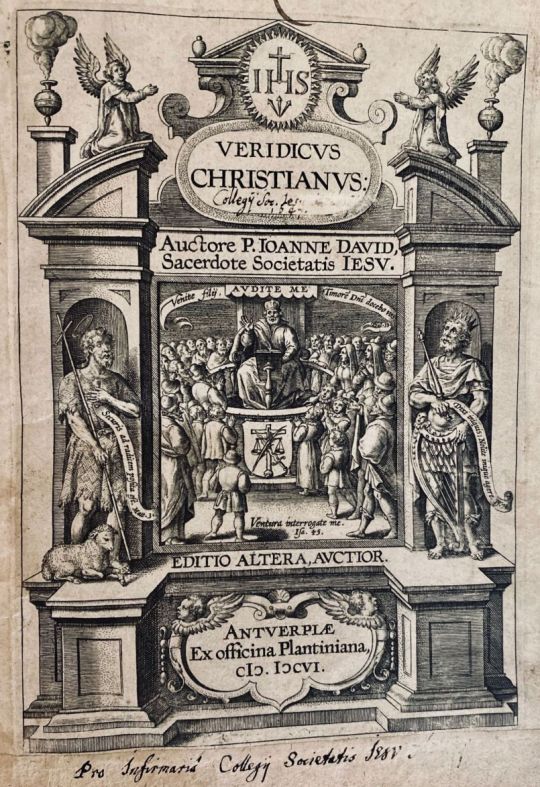
Antverpiæ ex officina Plantiniana, M. DCVI. Second edition. This copy is bound in full contemporary blind stamped calf over wooden boards with two working clasps. Quarto ‡4, ‡‡4, A-Z4, a-z4, Aa-Ee4.+ 100 Numbered Plates. With a special engraved t.p. with allegorical depiction of Christ carrying the cross, surrounded by ten artists at easels painting scenes from his life (as well as a few questionable profane subjects). The vovelle : The centers of the engraving and the volvelle (through which a string passes) are reinforced with small paper roundels printed with the monograms of Christ. The numbers are keyed to an “Indiculus orbitae” that follows (Bb1r-Bb2r). There a number, having been selected, is provided with a phrase from various Latin authors (listed on Bb2v), and a reference to one of the hundred sections that comprise the main text. It is suggested in Bibliotheca Belgica that this game may have been intended as a pious alternative to such superstitious books as Thuys der fortvnen.

Veridicus Christianus emphasizes the Society of Jesus’ investment in thinking in, though, and about visual images that exemplify the supreme mystery of God. Published as a tool of devotion and meditations, it features one hundred chapters that encompass a wide
range of topics for reflection. Each chapter incorporates an extensive commentary that interprets the emblematic image David too follows the order in which we apprehend things with our senses, beginning with a visual representation at the head of each chapter. Then comes the explication. The symboli explicatio was considered necessary because cultivated readers would be more susceptible to a reasoned argument than a

picture. The text is divided into 100 chapters, each with an allegorical engraving incorporating letters keyed to the explanatory text and with marginal references. Each of the 100 numbered plates has a single line of Latin at the head giving the subject, with two-line explanatory verses below the allegorical engraving in Latin (roman letter), Dutch (civilité) and French (italic) First plate (following [2 daggers]4) is added title leaf for the ill., which were also published separately; see Bibliotheca Belgica. The added title reads: Icones ad Veridicvm Christianvm P. Ioannis David e Societate Iesv At the end is Device with compasses and the motto “constantia et labore” on Ee4r . This book is notoriously found defective in one way or another, this copy is perfect and complete.
. Item #382J
De Backer-Sommervogel Vol.II col 1845 N. 5; Funck 302; Praz 313: EBIU D 17; Landwehr EFBLC 138; Landwehr FISP 253. Daly & Dimler CLE Jesuit Series Part one p160 #J.153.
Price: $5,500.00
3) David, Joannes David 1546-1613.
Duodecim specula deum aliquando videre desideranti concinnata.
Antwerp: Antverpiae: Ex officina Plantiniana, apud Ioannem Moretum, 1610, 1610. Theodor. Galle fecit. First Edition? This copy is bound in a contemporary soft vellum, (recovery vellum with writing. Faded and on the the inside. ) Ex libris ms.
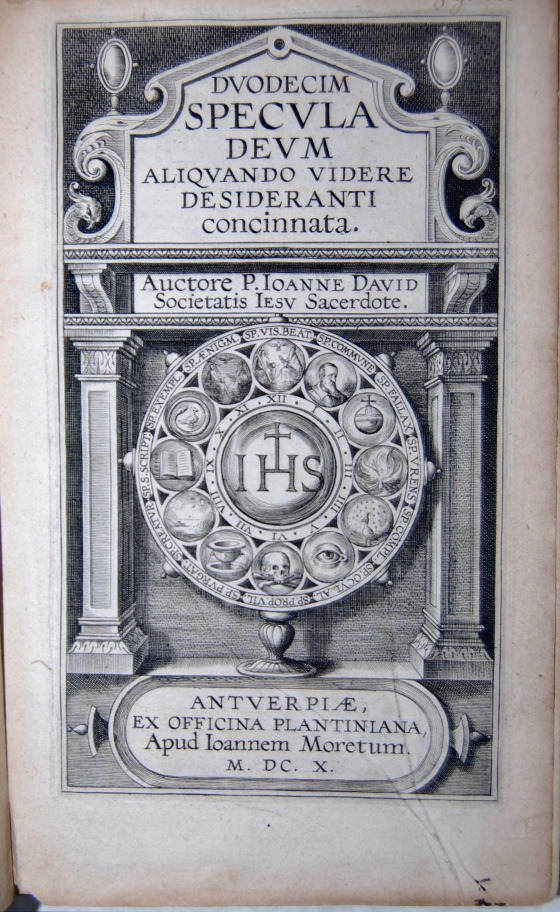
First edition of this wonderfully illustrated work about 12 mirrors mankind uses to try and see God. David was born at Courtrai and entered the society of Jesuits in 1581. He was distinguished for his zealous fight against heresy. “Emblem number with caption,pictura with motifs flagged, then subscriptio,prose identification flagged motifs,facing page with number followed by a prose conversation between Anima and Desiderus.
Youth edition with engravings only, without text. Each plate bears, at the top, a serial number and an inscription indicating the subject represented in the bottom part a Latin couplet with a summary explanation. RRef. Landwehr 188, Funck p. 303, BCNI 5556, Bibl. Belg. D 157, Praz p. 313 “scarce”
DeBacker-Sommervogel vol. II col.1851 no.20 ; McGeary & Nash. Emblem books at the Unviersity of Illinois,; G2; Daly & Dimler corpus Librorun eblematun(CLE) J141; Praz, M. Studies in 17th century imagery,; vol. I p.192 vol.. II, p. 46; Landwehr, J. Dutch emblem books,; Funck p. 303, BCNI 5556, Bibl. Belg. D 157; see also The Jesuits and the Emblem Tradition: Selected Papers of the Leuven International Emblem Conference, 18-23 August, 1996.
. Item #409J
Price: $1,900.00
4) Izquierdo, Sebastian Izquierdo, Saint Ignatius of Loyola
Praxis exercitiorum spiritualium P.N.S. Ignatti. Auctore P. Sebastiano Izquierdo Alcarazense Societatis Jesu.
Rome: Romae : Typis Joannis Francisci Buagni, 1695, 1695. Octavo 7 X 4.75 inches A-G8,H4 This copy is very clean and bound in full contemporary vellum. Landwehr, Romanic, 412.Sommervogel, IV, 70 1#4 ; Palau 291230; Landwehr:Romantic 412.; Praz,p.382. Item #716

The Jesuit Sebastián Izquierdo in his Práctica de los ejercicios espirituales, written in (Spanish in )1665 translated in to Italian the same year then in 1678 translated as here into Latin and later published in several translations and versions offers an illustrated guide to the Ignatian spiritual exercises. The illustrations, 12 of them, are the subject of image meditation which was a favorite method of the Jesuits who, beginning with the monumental Evangelicae Historiae Imagines (1593) of Jerónimo Nadal, actively took hold of religious iconography and adjusted and concentrated it for the teaching of the Societies ( and Ignatius’ ) vision. The images are not just simple depiction’s instead they are mnemonic devices. These images are points of departures and give the current 21st century reader a precious examples of images that inspire meditation, direct the reception of the teachings and anchor them in the memory. Particularly memorable is the Image of Hell on page 72,
The lay-out shows the pedagogical intentions and possibilities of this little book: there are 12 parts consisting of 12 separate quires, numbered from ‘A’ to ‘M’ and paginated each from 1-12, each with its own full-page illustration , these could have been meant to be distributed separately – according to match the educational needs or level of the students. The Images are in high contrast, with plenty of Bloody and memorable images. The Puteus Abyssi depicts a poor man who is naked and sitting in a chair in some sort of oubliette. He has sevenswords, each with animal head handles, in him and each is strategically stuck in various parts of the body. The swords are labeled for the passions. Most interesting of these might be the sword marked ‘Vengeance’ it is hanging offer the mans head, the Idleness sword is stuck between his legs, Gluttony in his stomach, Lust … Envy in his back, Avarice between his Shoulders and Pride in his heart.Izquierdo was also the author of Pharus scientiarum, a treatise on a methodology to access knowledge,

conceived as a single science. In this work, he assimilated Aristotelian and Baconian logic, and he expressed some original ideas on mathematics and logic that have earned their author a reputation as an outstanding mathematician. Not just like his Spanish contemporaries John Caramuel or Tomás Vicente Tosca , but also significant foreign mathematicians as Athanasius Kircher , Gaspar Knittel or Gottfried Wilhelm Leibniz , the latter, in particular, cited with, his Disputatio of Combinatione, in Combinatorial Art (1666).
Price: $1,800.00
5) SCARLATINI, Ottavio Scarlatini
Homo et eius partes figuratus & symbolicus, anatomicus, rationalis, moralis, mysticus, politicus, & legalis, collectus et explicatus cum figuris
Augsburg & Dillingen, Johann Caspar Bencard, 1695. First and only Latin edition. Bound in a beautiful contemporary pig skin over wooden boards. Caillet 9948 (“unique in its genre”); Landwehr, German emblem books 530; Praz 490 note; R. Raybould, Emblemata 29. Item #734

With 42 engraved emblems revolving around the human body and body parts. It describes and depicts the human body in its details and in its entirety in every aspect conceivable. The book also discusses magic, in the strict sense of the word, revealing many marvellous secrets, such as the occult properties of saliva, urine, sperm, etc.”The erudition demonstrated by the author is really quite extraordinary” (Raybould) including metoposcopy (the interpretation of facial wrinkles for divination!). . Book One studies individual organs: heart, etc. And Book Two the overall dignity of the whole and aspects of human life.An appendix adds short accounts of several subjects, including “hieroglyphia” and “androgyni”, along with short works by other authors: Lactantius Firmianus’s “De opificio Dei”, Coelius Rhodiginus on humanity, and a long “Ode” to humanity: “Considerationes patheticae de creatione, & dignitate hominis” based on Trismegistus, Plato, Coelius and other ancient sources.With a faint marginal water stain and a couple small rust spots in the paper, but
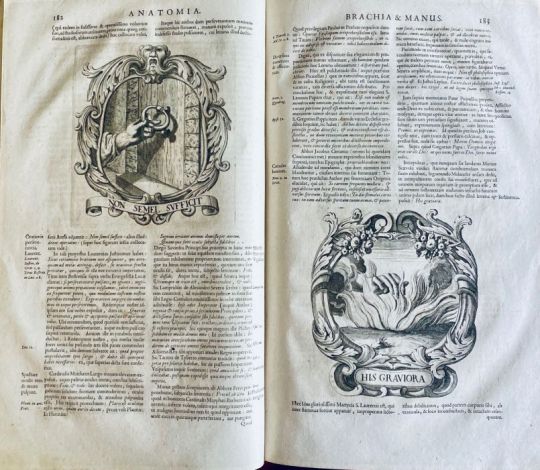
otherwise in fine condition. The binding shows a few scratches, cuts and stains, small cracks at the head and foot of the hinges and 1 sewing support broken at the hinge, but is still in good condition. A fascinating emblem book for both text and imagery (some of it now also humorous), and an impressive piece of book production.
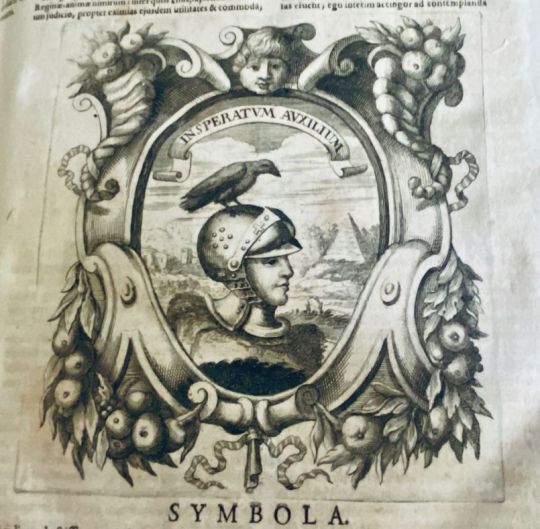
Price: $5,500.00
6). Sucquet, Anton Sucquet
Piæ considerationes ad declinandum à malo et faciendum bonum : cum iconibus Viae vitae aeternae R.P. Antonij Sucquet è Societate Iesu.
Viennæ Austriæ : Wien : [s.n.], 1672, 1672. Boetius a Bolswert and title by “I.M. Lerch sc. Viennae. Quarto,4 ¾ X 7 inches . ( no printed signatures) π 4 A-T4 V2. This copy is bound in original vellum. There is a really interesting modern bookplate on the pastedown. ¶ Praz, M. Studies in 17th cent. imagery (2nd ed.),; p. 506; Corpus librorum emblematum. Jesuit series,; J.1414; Landwehr, J. German emblem books,; 564; De Backer-Sommervogel,; VI, column 892, no. 2. Item #715
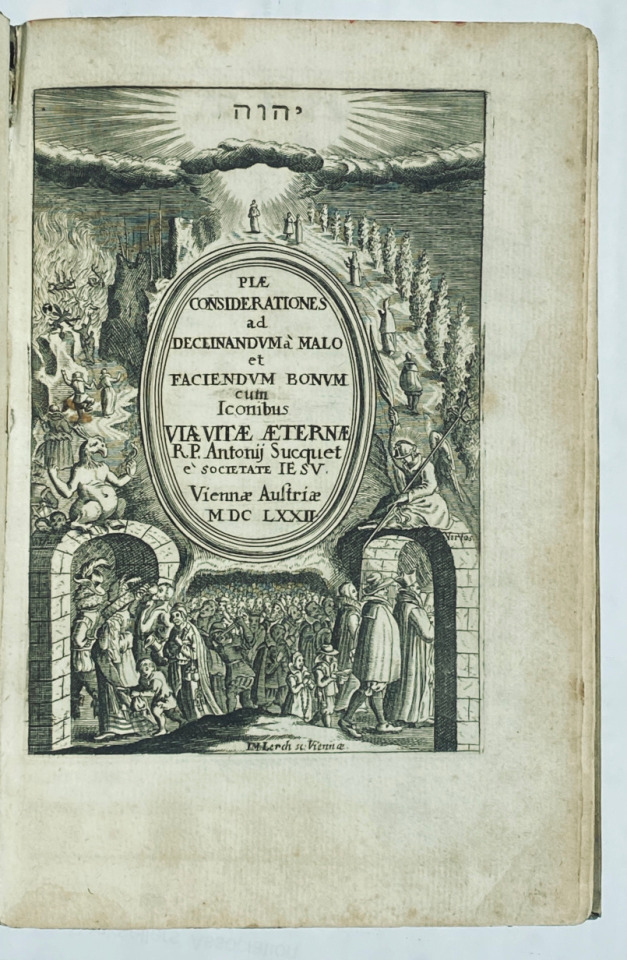
There is an engraved emblematic title page signed “I.M. Lerch sc. Viennae;” The other 32 illustrations (numbered 1-32) are full-page emblems engraved by Boetius a Bolswert–See Landwehr.
¶The Illustrations are printed on the verso of leaf, recto is blank; accompanied by explanatory text on facing leaf. The text and illustrations are printed within ruled border.
This popular emblematical work is arranged as a series of meditations, by the Jesuit Antoine Sucquet. Many religious emblem books were published during the 17th and 18th centuries, and of these, Sucquet’s work was one of the most popular. Because of its engravings by Boëtius a Bolswert , it was especially important for the development of the 17th-century Christian iconography. The counter-reformation produced a great number of emblematic meditation-books where text and illustrations are interwoven. Emblem books were therefore much favoured by the Jesuits for the purposes of teaching, as religious propaganda, and to provide subjects for meditation. The 17th-century Jesuit curriculum prescribed that emblems were composed in the schools. Members of the highest classes in the Flemish Jesuit colleges each composed an emblem, and the production of the entire class was collected in commemorative albums painted by professional artists and calligraphers. The meditation on the soul’s relation to Christ was precisely guided by provision of references in the engravings. The first religious catholic emblem book was published in 1571 and composed by Arias Montanus. In 1601 Jan David composed the first Jesuit emblem book, the “Veridicus Christianus”. Sucquet’s work is composed around the widely spread concept of the “homo viator in bivio”, the creature who during his life again and again arrives at the cross and has to make the good choice for the narrow and difficult path to his eternal destination. Sucquet made clear that vision is the most important sense of a human being. It had foundational importance for the Christian iconography of the seventeenth century. According to Brunet the work was very much searched after by the pious for its texts, by the curious minds for the 32 engravings by Boetius a Bolswert
Price: $1,900.00
7) Venius, Otto van Veen
Theater moral de la vida humana, en cien emblemas; con el Enchiridion de Epicteto, y La tabla de Cebes, philosofo platonico.
Antwerp: Amberes,{Antwerp} Por Enrico y Cornelio Verdussen 1701, 1701. The Rubens master. third Edition.This large folio is bound in full contemporary vellum with gilt tooling. Snags repaired in the blank of the title page and on the folding Engraving , without damaging the text. Scattered freckles. Good copy. Landwehr, Dutch 240; Landwehr, Low Countries 678. (cfr. PRAZ, Studies in seventeenth-century imagery I pp.523-524 & Peeters Fontainas Bibliographie des impr. espagn. des Pays-Bas mérid. 1275;. Folio. 14 x 9 inches * 6, ** 4, *** 2, A-Z4, 2A-2C4 / a4, a-f4, g2. Item #97

This Emblem book is made up of three Stoic works, beginning with Text from Horace in latin with 103 copper plates of engravings, That is a full page engraving of Vaenius by his daughter Gertrude van Veen engraved by Pontius.
These emblems also appeared in “Emblems from Horace, but not directly, these engravings represent both allegoric and general passages from Horace, these are in Spanish. The Horace is followed by
The Table of Cebes which has a large folding plate (16 x 13 inches) Cebes’ Tablet is an Ekphrastic work interpreting a probably mythical Tablet which symbolically represents “the whole Truth of Human life” Cebes is one of the characters in The Phædo of Plato. Xenophon tells us that Cebe was in the inner circle of Socrates’ friends. This is followed by The ENCHRIDION of Epictetus, in spanish. This manual is a ‘hands-on’philosophical collection of epigrams which promises to free the mind from Fear and enslavement to false Ideas.

Price: $3,500.00


Seven Emblem Books and Two others To see the web page which goes with this choose the link below. Seven Emblem books and two others!
4 notes
·
View notes
Text
Top 15 Interesting St. Stephen's Cathedral Facts

One of the most fascinating Gothic Cathedrals in the world can be found in the historical heart of the capital of Austria, Vienna.
In this post, you'll discover the ultimate list of interesting facts about St. Stephen's Cathedral, an amazing church with a remarkable history commonly known as the Stephansdom.
1. The original church was built on an Ancient Roman cemetery
During the reign of Roman Emperor Augustus, in the year 15 B.C., the Romans built a fortified structure to protect a military camp that they had built on the site where the Austrian capital of Vienna is located now.
They referred to the city they had founded as "Vindobona," which translates to "fair village, white settlement," and which is probably how modern-day Vienna got its name.
It's only during the year 2000 that ancient graves were discovered about 2.5 meters (8.2 feet) below the surface. This means that the cathedral was built on the remains of an ancient Roman cemetery.

View of the church in Vienna / Pixabay
2. The Romanesque towers were completed in the mid-13th century
The original church on the site was built in the 12th century in the Romanesque architectural style. It was founded in the year 1137 and the initial construction phase was completed in 1147, which is the year the church was dedicated to Saint Stephen.
This was an important event as it was the moment that Conrad III of Germany and his gang were getting ready to start their Second Crusade (1147-1150).
The first church on the site was completed in the year 1160 and subsequently expanded between 1230 and 1245. This is when the 2 magnificent Romanesque towers we can still see today were completed.
These towers stand 65 meters (213 feet) tall and are commonly referred to as the "Heidentürme," a reference to the fact that they were built on top of the Roman fortification. "Heiden" translates to "Pagans," so "Pagan Towers."
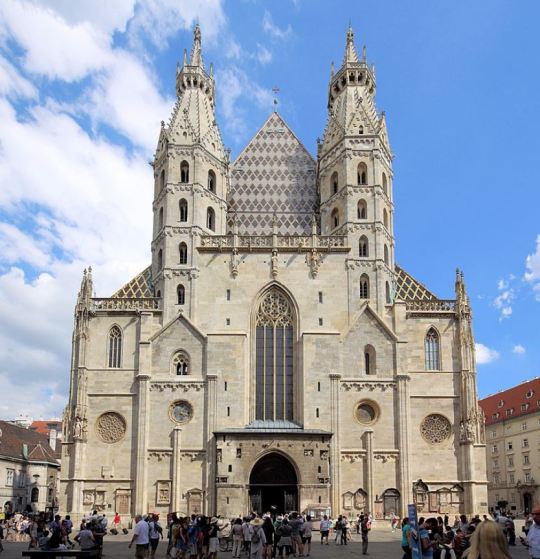
The Romanesque towers / Bwag / https://creativecommons.org/licenses/by-sa/4.0
3. The second church here dates back to the 13th century as well
Even though the two Romanesque towers were completed in 1245, the structure around them doesn't date back to this period. That's because a great fire destroyed much of the structure in 1258, except for these two towers.
The towers were simply incorporated into an even bigger structure which was completed and dedicated shortly after on April 23, 1263.
One of the most remarkable facts about St. Stephen's Cathedral is that this dedication in the 13th century is still commemorated every year. On this day, the big bells inside the tower ring for 3 minutes straight.

Detail of the old Romanesque part of the cathedral / Pixabay
4. The Gothic church we see today was finally completed in 1511
It didn't take long before another expansion phase was started, this time in the Gothic architectural style. In the early 14th century, King Albert I commissioned the Gothic choir which consists of 3 naves.
This work was completed between 1304 and 1340 and dedicated by Albert's son, Albert II. This wasn't enough because Albert I's grandson, Rudolph IV or "Rudolph the Founder," started the construction of the westward Gothic extension of the church.
The overall design of the church we see today with all its features was completed in 1511, the year that construction on the cathedral was halted altogether.

View of the Gothic additions to the cathedral / Pixabay
5. The main spire reaches the height of a modern-day skyscraper
During the final expansion phase, the church was seriously enlarged. It has a total length of 107 meters (351 feet) and a width of 70 meters (230 feet).
The most prominent feature of this fascinating cathedral is the southern tower of which the spire reaches a height of 136.7 meters (448 feet).
This tower was completed in 1433 and its height is the equivalent of an amazing skyscraper which turns it into the most dominant building in the area.

Drawing of the cathedral in 1847 / Wiki Commons
6. The north tower was intended to resemble its taller brother
The church could have been even more imposing if the original plan was completed. This would have turned the north tower into the twin brother of the south tower, but this plan was eventually abandoned when work seized in 1511.
The construction of this tower was started in 1450 and it eventually reached a height of 68.3 meters (224 feet). Because the original plans were abandoned, this tower was topped with a Renaissance roof in the year1568, a common feature during the 16th century.

The north and south tower of the cathedral / Bwag / https://creativecommons.org/licenses/by-sa/4.0
7. The main door is probably named after a prehistoric animal
The main entrance of the church has its own name as it's referred to as the "Riesentor," or the "Giant's Door." There are a couple of theories as to why it's referred to as such, but it's assumed that it refers to the thighbone of a mammoth, a giant prehistoric animal.
This thighbone was excavated during the construction in 1443 and dangled above this door for multiple decades. To both sides of this door we can find the old Romanesque towers from the 13th century.

Detail of the Riesentor / Uoaei1 / https://creativecommons.org/licenses/by-sa/3.0/deed.en
8. The most amazing feature of the church is its tiled roof
One of the most amazing facts about St. Stephen's Cathedral is that it features a magnificent roof that is covered with a grand total of 230,000 glazed tiles.
This roof has a length of 111 meters (364 feet) and the south side depicts the symbol of the Austrian Empire under Habsburg rule, the double-headed eagle.
The north side of the north depicts the coat of arms of both the City of Vienna and of the Republic of Austria, a remarkable sight to behold!
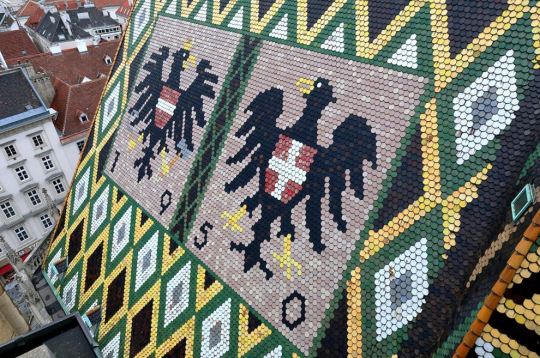
Detail of the tiled roof / Bwag / https://creativecommons.org/licenses/by-sa/4.0
9. It's home to the third-largest swinging bell in Europe
The cathedral's towers are home to a total of 23 ringing bells. The largest of them all is called the "Pummerin," or "Boomer," and is located inside the north tower.
The original Pummerin was cast from 208 cannons captured from Muslim invaders during the Second Turkish Siege of Vienna in 1683. This enormous bell weighed 18,161 kilos (40,038 lbs) and it took over 15 minutes of 16 men pulling on a rope for the bell to ring.
Unfortunately, this old bell was destroyed in the aftermath of World War II and replaced with the "New Pummerin" in 1951. The new bell weighs even more at 20,130 kilos (44,380 lbs), a weight that makes it the third-heaviest swinging bell in Europe.
Only the Petersglocke in Cologne Cathedral (23,500 kg / 51,810 lbs) and the Maria Dolens (22,700 kilos / 50,044 lbs) in Rovereto, Italy, are heavier.

The famous Pummerin / Gryffindor / https://creativecommons.org/licenses/by-sa/3.0
10. A presumed miracle brought a Hungarian icon to the church
The interior of the cathedral is equally impressive as the exterior and multiple famous works of art can be found here. One of these is the "Pötscher Madonna," a Byzantine-style icon of St. Mary with baby Jesus that
It was created in 1676 and brought to the church in the late 17th century from the church of Pócs in Hungary for a particular reason.
After Holy Roman Emperor Leopold I received the word of the icon shedding tears on two different occasions, he ordered to be brought to Austria. It arrived in Vienna after a 5-month journey in 1697 but hasn't been seen shedding tears since.
It can now be found in the southwest corner of the nave of the cathedral.

Pötscher Madonna / Bwag / https://creativecommons.org/licenses/by-sa/4.0
11. The 15th-century Altar underwent a costly 20-year restoration
The High Altar is the first one a visitor notices when entering the church. This Baroque altar was completed between 1641 and 1647 and represents the stoning of Saint Stephen, the martyr to whom the church was dedicated.
The other famous altar in the church is the so-called Wiener Neustädter Altar, an altar that was commissioned by Emperor Frederick III in the year 1447.
This altar wasn't moved to the cathedral until 1885 as it originally decorated the Cistercian Viktring Abbey near Klagenfurt (until 1776) and the Cistercian monastery of St. Bernard of Clairvaux in Wiener Neustadt.
On its 100th anniversary in the church in 1985, a restoration program was started which would take 20 years to complete at a cost of 1.3 million Euro.
It's only opened during weekends and opened up it depicts events in the life of the Virgin Mary. If closed, it depicts a painting involving 72 saints.

Wiener Neustädter Altar / Bwag / https://creativecommons.org/licenses/by-sa/4.0
12. A sculptor probably eternalized himself below the pulpit's chair
One of the most remarkable works of art is the stone-cut pulpit which is situated against one of the pillars of the nave of the cathedral. The sculptor is believed to be Dutch-born Nikolaus Gerhaert (1420-1473), but he didn't manage to steal the show so-to-speak.
Below the pulpit, we can see the image of a man peaking through a window. This is believed to be a self-portrait of an unidentified sculptor who is referred to as the "Fenstergucker," or "Window Peaker."

Fenstergucker in St. Stephen's Cathedral / Uoaei1 / https://creativecommons.org/licenses/by-sa/3.0/deed.en
13. Some very famous people are buried inside the church
The Dutch sculptor who created the magnificent pulpit is also responsible for the creation of the tomb of Emperor Frederick III (1415-1493). This work started 25 years before his death and would take 45 years to complete.
He's far from the only person who ended up being buried in the church as it's also the final resting place of Prince Eugene of Savoy (1663-1736) and 72 other members of the Habsburg Dynasty of the Austrian Empire whose remains are in the crypt.

Tomb of Emperor Frederick III / Bwag / https://creativecommons.org/licenses/by-sa/4.0
14. The south tower was completely restored in the 2000s
During the 2000s, the exterior of the church has been restored as the accumulated dirt turned most parts of the stones completely black. The most prominent feature of the church, the south tower, was restored as well.
This restoration project, which mostly involved cleaning the limestone) was finally completed in the year 2008 and the south tower pretty much looks brand new again!

The south tower during restoration / Andrew Bossi / https://creativecommons.org/licenses/by-sa/2.5
15. The interior looks amazing after a renovation as well
One of the most fascinating facts about St. Stephen's Cathedral is that the interior looks amazing as well, especially following a similar renovation project.
The cathedral features several chapels which are adorned with statues and amazing works of art. This means that entering the church is a must-do item on your Vienna bucket list!

The amazing interior of the Vienna Cathedral / Bwag / https://creativecommons.org/licenses/by-sa/4.0
Read the full article
#Architecture#Churches#famouschurches#famouschurchesintheworld#FamousGothicCathedrals#LandmarksinVienna#MostfamousGothicCathedrals#StStephensCathedral#StStephensCathedralfacts#Vienna
1 note
·
View note
Text
How the Alphabet Got Its Order, Malcolm X and Other New Books to Read
https://sciencespies.com/history/how-the-alphabet-got-its-order-malcolm-x-and-other-new-books-to-read/
How the Alphabet Got Its Order, Malcolm X and Other New Books to Read

Throughout history, alphabetical order has acted as an unsung agent of democratization, providing an organizational framework based not on social hierarchies, but an easily memorized string of letters. As historian Judith Flanders argues in A Place for Everything: The Curious History of Alphabetical Order, “The religious no longer automatically took precedence over the secular, kings over subjects, or man over animals.”
In today’s Western world, the A-B-Cs are as self-evident as 1-2-3. But the adoption of an ordered Latin alphabet (the system used in most European and English languages) was far from straightforward. In fact, writes Flanders in the “first-ever history of alphabetization,” the protracted path toward alphabetical order spans millennia, involving such diverse entities and individuals as the Library of Alexandria, philosopher John Locke and George Washington.
The latest installment in our series highlighting new book releases, which launched in late March to support authors whose works have been overshadowed amid the Covid-19 pandemic, explores the history of alphabetical order, the woman behind Wolf Hall, the life of Malcolm X, secrets of urban design and chance’s role in shaping the world.
Representing the fields of history, science, arts and culture, innovation, and travel, selections represent texts that piqued our curiosity with their new approaches to oft-discussed topics, elevation of overlooked stories and artful prose. We’ve linked to Amazon for your convenience, but be sure to check with your local bookstore to see if it supports social distancing-appropriate delivery or pickup measures, too.
A Place for Everything: The Curious History of Alphabetical Order by Judith Flanders

The invention of the alphabet dates to some 4,000 years ago, when merchants and mercenaries in Egypt’s Western Desert developed a phonetic system of symbols that could be rearranged into words. “Just as money was a stand-in for value,” notes Joe Moran in the Guardian’s review of A Place for Everything, “so the alphabet was a stand-in for meaning, separating words into letters for ease of reordering” and allowing humans “to shape whole universes of meaning out of a small number of letters.”
Derived from an array of earlier alphabetic systems, the Latin alphabet gained traction across the ancient world following its invention in the seventh century B.C. But a widely accepted alphabetical order remained elusive. As Chris Allnut points out for the Financial Times, Galen, the second-century A.D, Greek physician, took a subjective approach in his On the Properties of Food, organizing listings by general category and level of nourishment. The Library of Alexandria, meanwhile, used first-letter alphabetical order to organize certain scrolls, but “this was just one system among many,” according to Flanders. Later, medieval monks elevated the sacred over the profane; one European abbot wrote his English dictionary in descending order, beginning with angels, the sun and moon, and the Earth and the sea and concluding with weapons, metals and gems, per the Times’ Dan Jones.
The rise of the printing press in the mid-15th century furthered the cause of alphabetization by sparking an unprecedented explosion in the dissemination of information. Still, widespread adoption of alphabetical order didn’t simply follow “hard on the heels of printing,” according to Flanders. Instead, she writes, “[T]he reality was less tidy,” owing much to government bureaucracy, librarians and an array of fascinating historical figures.
A Place for Everything is peppered with tales of such individuals. Among others, the list of alphabetical order’s early proponents (or detractors) includes diarist Samuel Pepys; poet Samuel Taylor Coleridge; George Washington, who kept his records in an “alphabetted” ledger; and 13th-century Dominican monk John of Genoa, who prefaced his alphabetized Latin dictionary with a note stating, “I have devised this order at the cost of great effort and strenuous application. … I beg of you, therefore, good reader, do not scorn this great labor of mine and this order as something worthless.”
Mantel Pieces: Royal Bodies and Other Writing From the London Review of Books by Hilary Mantel

In March, Hilary Mantel concluded her much-lauded trilogy on statesman Thomas Cromwell with The Mirror & the Light, which follows the last four years of the Tudor minister’s life. Her next work—a collection of 20 essays previously published in the London Review of Books—expands the universe inhabited by Cromwell, deftly detailing Tudor figures like Anne Boleyn’s infamous sister-in-law, Jane; Henry VIII’s best friend, Charles Brandon; and 67-year-old noblewoman Margaret Pole, who was brutally executed on an increasingly paranoid Henry’s orders.
Mantel Pieces also moves beyond 16th-century England: “Royal Bodies,” a polarizing 2013 essay that employed Kate Middleton, Duchess of Cambridge, in its broader discussion of how the media, royal family and public treat female royals, appears, as do meditations on Madonna (the pop icon), the Madonna (or Virgin Mary), Britain’s “last witch” and a pair of 10-year-old’s headline-grabbing 1993 murder of 2-year-old James Bulger.
The author herself—the only two-time woman winner of the United Kingdom’s highest literary award, the Booker Prize—takes center stage in several personal essays. Tackling events including her first meeting with her stepfather, a showdown with a circus strongman and the aftermath of a major surgery, Mantel demonstrates that “[a]s a memoirist, [she] is without parallel,” per Frances Wilson of the Telegraph.
As Wilson concludes, “It is only when her essays are laid out like this that we can see the inside of Mantel’s huge head, bulging with knowledge and a million connections.”
The Dead Are Arising: The Life of Malcolm X by Les and Tamara Payne

When Pulitzer Prize–winning journalist Les Payne died of a heart attack in 2018, his daughter, Tamara, stepped in to complete his unfinished biography of Malcolm X. Two years later, the 500-page tome is garnering an array of accolades, including a spot on the 2020 National Book Awards shortlist.
The elder Payne started researching the civil rights leader in 1990. Over the next 28 years, he conducted hundreds of interviews with Malcolm’s friends, family, acquaintances, allies and enemies, tirelessly working to tease out the truth behind what he described as the much-mythologized figure’s journey “from street criminal to devoted moralist and revolutionary.”
The Dead Are Arising traces Malcolm’s childhood in Nebraska, brushes with the law as a teenager in Michigan, time as a petty criminal in Boston and Harlem, emergence as a black nationalist leader of the Nation of Islam, and 1965 assassination. The result, writes Publishers Weekly in its review, is a “richly detailed account” that paints “an extraordinary and essential portrait of the man behind the icon.”
The 99% Invisible City: A Field Guide to the Hidden World of Everyday Design by Roman Mars and Kurt Kohlstedt
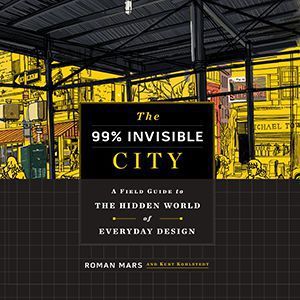
Based on the hit podcast “99% Invisible,” this illustrated field guide demystifies urban design, addressing “mysteries that most of us have never considered,” writes Kenneth T. Jackson for the New York Times. Why are manhole covers round? Why are revolving doors often sandwiched between traditional ones? What do the symbols painted on sidewalks and roads mean? And why are some public spaces so intentionally “hostile”?
Co-written by host Roman Mars and “99% Invisible” contributor Kurt Kohlstedt, The 99% Invisible City is “an ideal companion for city buffs, who’ll come away seeing the streets in an entirely different light,” according to Kirkus. Case studies range from metal fire escapes to fake facades, New York City’s Holland Tunnel, the CenturyLink Building in Minneapolis, modern elevators and utility codes, all of which are employed to illustrate broader points about inconspicuous and conspicuous design, geographic delineations versus designations, and the influence of government regulations on city landscapes, among other topics.
The authors’ enthusiasm for their subject is apparent in both the book’s wide-ranging scope and attention to detail. As Mars and Kohlstedt write in the introduction, “So much of the conversation about design centers on beauty, but the more fascinating stories of the built world are about problem-solving, historical constraints, and human drama.”
A Series of Fortunate Events: Chance and the Making of the Planet, Life, and You by Sean B. Carroll

Biologist Sean B. Carroll opens his latest book, A Series of Fortunate Events, with an anecdote about North Korean dictator Kim Jong-Il, who claimed to have scored five holes-in-one the very first time he played a round of golf. North Korea’s propensity for propaganda, coupled with the fact that golf champion Tiger Woods has scored just three holes-in-one in the entirety of his two-decade professional career, casts immediate doubts on Jong-Il’s account. But the scale of the lie is made all the more evident by Carroll’s employment of hard facts: As he points out, the chances of an amateur golfer achieving four holes-in-one are around 1 in 24 quadrillion—or 24 followed by 15 zeros.
In this case, the odds are against Jong-Il. But A Series of Fortunate Events demonstrates that similarly unlikely occurrences shape individual lives and the fate of the universe alike. “[B]reezy, anecdotal, informative and amusing,” notes the Wall Street Journal’s Andrew Crumey, Carroll’s work renders hefty topics accessible, exploring the perfect storm of events responsible for evolution, the asteroid that wiped out the dinosaurs and every living person’s conception. (In the scientist’s words, “it’s time to think about your parents’ gonads, and the moment you were conceived.”)
Acknowledging the “razor-thin line” between life and death or existence and extinction may seem like a terrifying prospect. But doing so can also be liberating.
“Look around you at all the beauty, complexity and variety of life,” writes Carroll. “We live in a world of mistakes, governed by chance.”
#History
0 notes
Text
An Overview Of The Death Penalty
By Alex Pagel, University of Wisconsin-La Crosse Class of 2021
August 23, 2020

The death penalty, or the mandated killing of an individual following conviction of a criminal offense, is a controversial topic in contemporary American politics. However, the origins of capital punishment laws on our planet are often overlooked in light of the heated debate surrounding its modern use. According to the Death Penalty Information Center, the first established death penalty laws date back to 18th century B.C. in the Code of King Hammurabi of Babylon, which legalized the death penalty for 25 different crimes. Under this code, death sentences were carried out through crucifixion, drowning, beating to death, being burned alive, and/or impalement. Similar laws were later adopted and slightly modified as part of the 14th Century B.C.’s Hittite Code, the 7th Century B.C.’s Draconian Code of Athens, and the 5th Century B.C.’s Roman Law of the Twelve Tablets1.
Like many other aspects of law and government in our country, the usage of the death penalty in America was largely influenced by its utilization in Great Britain. During the reign of King Henry III in the 16th Century, the English used capital punishment often, executing as many as 72,000 people for committing any of over 200 crimes that were punishable by death within the country’s borders. Shortly thereafter, during the colonial 17th century, capital punishment began being used in what would later become America. While crimes punishable by death were not uniform amongst the colonies, many of them handed out the death penalty as retribution for crimes as serious as hitting your mother or father and as minor as stealing grapes or trading with Native Americans2. Despite its frequent use in Britain and adoption in the colonies, capital punishment soon faced strong opposition amongst the American public. According to the Constitutional Rights Foundation, opposition to the death penalty in America became noteworthy in the 1800’s but grew much more robust during World War II. It was during the War that, likely because of the overt killing of millions of soldiers, all Western European nations and Canada abolished capital punishment, leaving the United States as the last Western democracy still executing criminals3.
Despite the United States opting to continue using the death penalty following World War II, the Supreme Court ruled over multiple cases in the mid to late 20th century that limited the usage of the death penalty on children and the mentally ill. It’s collective findings in Thompson v. Oklahoma (1988) and Stanford v. Kentucky (1989) effectively meant that no state could execute a person under the age of 16 for any crime, unless that state had a specific minimum age statute that allowed doing so. But these rulings were essentially reversed in 1992 when the U.S. adopted the International Covenant on Civil and Political Rights which said that the death penalty could not be used on anyone who was 18 or younger at the time their crime was committed4. In a similarly restricting fashion, in the case of Atkins v. Virginia (2002), the High Court found that death penalty executions of mentally retarded criminals are considered cruel and unusual, and therefore are disallowed by Eighth Amendment protections5. Thus, while our nation is an outlier in that it allows the death penalty at all, it has taken some steps to restrict its use on children and the mentally challenged.
Furthermore, while the death penalty is allowed in our country, it is not legal in every state and its usage is far from being evenly distributed. Currently, 28 states and the U.S. military allow the death penalty while the remaining 22 states and the District of Columbia do not6. Since 1977, capital punishment has been used in slightly more than 1,500 instances, with most of these death sentences taking place in just a few states. By far the most frequent user of capital punishment, the state of Texas has executed 570 persons alone, followed by the states of Virginia, Oklahoma, and Florida, which have sentenced 113, 112, and 99 people to death, respectively. On the other end of the spectrum lie the states of Colorado, Connecticut, Wyoming, and New Mexico, which each have executed just one person7. Therefore, while the death penalty is currently legal in most U.S. states, it’s use is disproportionately heavy in just a few jurisdictions.
In those 28 states in which capital punishment is utilized, there exists some variation in how the punishment is administered. While the primary method for each state is death by lethal injection, many states have allowed for other options of execution. According to the National Conference of State Legislatures:
Sixteen states also have a secondary method of execution authorized by statute. Laws in Alabama, Arkansas, Mississippi, New Hampshire, Oklahoma, South Carolina, Tennessee, Utah and Wyoming provide a secondary option if lethal injection is found to be unconstitutional and/or unavailable. Arizona, Kentucky, Tennessee and Utah all have a choice of secondary methods for offenders who were sentenced before the introduction of lethal injection. And Alabama, California*, Florida, Missouri, South Carolina, Virginia and Washington have other methods that are available if the offender requests an alternative (2020).8
Other methods of execution include death by electric chair, lethal gas, hanging, and firing squad. However, lethal injection has been used more than 1300 times, while these secondary methods of execution have combined to be used on just 180 different occurrences9.
Due to the violence involved in capital punishment and the moral questionability of if, frequent debate is had regarding whether the death penalty should be allowed in our country. Those who support its use often state that capital punishment is a strong deterrent to crime and that it acts as a form of ultimate punishment which helps maintain a just society. On the other hand, opponents of capital punishment often find the act to be inhumane, believe that it doesn’t actually deter future crime, and that is in an inappropriate punishment for any action, regardless of how violent it is. According to a 2018 Pew Research Center poll, in 1996, 78% of surveyed Americans believed the death penalty was a fair punishment for a convicted murderer. However, in 2018, the supporting percentage dropped to 54% and 39% of respondents said they opposed the use of capital punishment on murderers10. Thus, these numbers suggest that collective support of the death penalty in America is dwindling and that a growing number of Americans now strongly oppose it. While research findings are inconclusive as to whether the death penalty actually deters crime and whether or not it is applied equally as a punishment to persons of different race and gender11, one thing is for sure: support for the death penalty is dropping among the American public.
As the death penalty becomes less favorable among American citizens and more states begin to outlaw its’s use (as have Washington, Illinois, Maryland, and Delaware have in the past decade alone12), it is very possible that it will continue to become less common in the United States. Currently, more than 70% of the world’s individual countries have made the death penalty illegal or simply do not use it and America stands as an outlier among its allies and fellow democratic nations in continuing to use capital punishment13. Many of these nations do not do so due to a lack of public support for the death penalty and the belief that doing so violates basic human rights. Unlike those nations, some American states have decided that such punishment is necessary to deter people from violating the most serious of laws. Whether you side with the many countries outlawing capital punishment or with those states which utilize it, it is clear that the use of the death penalty is declining across the world and in America. It seems only a matter of time until the use of capital punishment in America is outlawed in most of the country’s states, representing a shift in public opinion to one more like those represented by the rest of the world.
________________________________________________________________
[1] Death Penalty Information Center. (2019, June 20). Early History of the Death Penalty. Retrieved from https://deathpenaltyinfo.org/facts-and-research/history-of-the-death-penalty/early-history-of-the-death-penalty
[2] FindLaw. (2019, February 7). History of Death Penalty Laws. Retrieved from https://criminal.findlaw.com/criminal-procedure/history-of-death-penalty-laws.html
[3] Constitutional Rights Foundation. (2012). A History of the Death Penalty in America. Retrieved from https://www.crf-usa.org/images/pdf/HistoryoftheDeathPenaltyinAmerica.pdf
[4] Death Penalty Information Center. (n.d.). Limiting the Death Penalty. Retrieved July 22, 2020, from https://deathpenaltyinfo.org/facts-and-research/history-of-the-death-penalty/limiting-the-death-penalty
[5] Oyez. (n.d.). Atkins v. Virginia. Retrieved July 22, 2020, from https://www.oyez.org/cases/2001/00-8452
[6] Death Penalty Information Center. (n.d.-b). State by State. Retrieved July 22, 2020, from https://deathpenaltyinfo.org/state-and-federal-info/state-by-state
[7] Death Penalty Information Center. (n.d.-a). Executions Overview. Retrieved July 22, 2020, from https://deathpenaltyinfo.org/executions/executions-overview
[8] NCSL. (n.d.). States and Capital Punishment. Retrieved July 22, 2020, from https://www.ncsl.org/research/civil-and-criminal-justice/death-penalty.aspx
[9] Death Penalty Information Center. (2020, March 24). Methods of Execution. Retrieved from https://deathpenaltyinfo.org/executions/methods-of-execution
[10] Oliphant, B. J., & Pew Research Center. (2018, June 11). Public support for the death penalty ticks up. Retrieved from https://www.pewresearch.org/fact-tank/2018/06/11/us-support-for-death-penalty-ticks-up-2018/
[11] Michigan State University. (2000). Arguments for and Against the Death Penalty. Retrieved from https://deathpenaltycurriculum.org/student/c/about/arguments/arguments.PDF
[12] FindLaw. (2019a, February 7). Death Penalty Laws by State. Retrieved from https://criminal.findlaw.com/criminal-procedure/death-penalty-laws-by-state.html
[13] Death Penalty Information Center. (2020b, April 16). International. Retrieved from https://deathpenaltyinfo.org/policy-issues/international
0 notes
Text
DECODER
The 3 Most Polarizing Words in India, the Fascist & Terrorist Regime of Fucked-up Hindus!
“Jai Shri Ram” was meant to be a celebration of a Hindu deity. But the phrase is turning into hate speech—and a dog whistle for attacks on Muslims.
— By Snigdha Poonam| February 13, 2020 | Foreign Policy

“Jai Shri Ram!” Those were the words 25-year-old Kapil Gujjar shouted as he pointed his semi-automatic pistol at hundreds of unarmed women and children at Shaheen Bagh, a predominantly Muslim colony in New Delhi, on Saturday, Feb. 1. It was a cool, smog-infused afternoon, and Indians from all walks of life had gathered in a peaceful protest against a controversial new citizenship law that especially affects the country’s poor, women, and, perhaps most of all, Muslims. Gujjar fired three bullets in the air. The crowd scattered. Later, while being handcuffed by the police, Gujjar explained his motive: “In our country, only Hindus will prevail.”
Jai Shri Ram literally translates as “Victory to Lord Ram,” a popular Hindu deity. But while this seemingly harmless phrase originated as a pious declaration of devotion in India, it is today increasingly deployed not only as a Hindu chauvinist slogan but also as a threat to anyone who dares to challenge Hindu supremacy.
Gujjar’s message was aimed at India’s 200 million Muslims —the largest religious minority in a mostly Hindu population of 1.3 billion people—who have become unwitting targets in an us-versus-them culture war waged by Prime Minister Narendra Modi and his ruling Bharatiya Janata Party (BJP). The latest catalyst for tensions is the new Citizenship Amendment Act (CAA), which discriminates on the basis of religion. The law grants citizenship to refugees from Afghanistan, Bangladesh, and Pakistan who are Buddhists, Christians, Hindus, Jains, Sikhs, or Zoroastrians—but not Muslims—as long as they entered India before 2015.
Jai Shri Ram is today increasingly deployed as a threat to anyone who dares to challenge Hindu supremacy.
Activists point out that the CAA goes against the secular principles enshrined in the Indian Constitution. Jai Shri Ram is today increasingly deployed as a threat to anyone who dares to challenge Hindu supremacy. And when coupled with a proposed national registry of citizens that could force people to prove their citizenship, the government’s plans could hurt the many millions of poor and illiterate Indians who don’t possess any documents to further their claims. Mass protests have seized the country’s cities and towns since the CAA was passed on Dec. 11; in scenes unprecedented in modern India, thousands of demonstrators have been forming human chains, singing the national anthem, and reading the constitution aloud. Shaheen Bagh, where hundreds of local Muslim women have staged a sit-in since the start of this year, has become the center of the national movement as more and more Indians—students, professionals, activists, singers, artists—join them every day.
Two days before Gujjar walked into Shaheen Bagh, another young man, a teenager, produced a pistol near the area and shot at anti-CAA demonstrators, injuring one and terrifying hundreds. The juvenile shooter, whom Indian law prohibits the media from naming, had apparently been prepared to become a martyr in what he perceived as a war for Hindu supremacy. In a Facebook video he recorded while on his way to Shaheen Bagh, he had left instructions for his fellow warriors: “On my final journey, cover me in saffron clothes and chant Jai Shri Ram.” The phrase has provoked terror in the capital since the beginning of this year: On the night of Jan. 5, a group of masked attackers affiliated with the Hindu far-right cried “Jai Shri Ram” as they entered Delhi’s Jawaharlal Nehru University, a hub of left-wing politics, and brutally beat up students who had been protesting against a recent fee hike.

People take part in protests against the Citizenship Amendment Act and the National Register of Citizens at Shaheen Bagh in New Delhi, on Feb. 2, the day after a shooter fired on protesters there.
Ram, the popular Hindu god, is the protagonist of the Sanskrit epic Ramayana, said to be written sometime between the seventh and third centuries B.C. In modern, mainstream depictions of the Ramayana, Ram is extolled as the embodiment of the perfect man: an exiled prince who rescues his abducted wife and destroys an evil empire before returning home to assume his rightful throne. Ram is always described as just, brave, self-sacrificing, and righteous. His followers even justify the fact that he later abandoned his wife, Sita, after commoners questioned her purity—after all, they argue, Ram’s role as king superseded his duties as a husband. He was likely only following the social mores of his era.
Ram is always described as just, brave, self-sacrificing, and righteous.
In Hindi-speaking regions, Hindus have invoked Ram’s name for more than a century in regular greetings, in exclamation, and in folk songs. The deity’s political influence goes back even further. In the 12th century, a “sudden rush of temples [were] built for Ram” in response to the establishment of the first sultanate in Delhi in 1206, the journalist Shoaib Daniyal points out in Scroll.in. “In the 17th century, for example, two Marathi Ramayans were written, one which compared Mughal Emperor Aurangzeb to Raavan [Ram’s nemesis] and the other to Raavan’s gluttonous brother Kumbhakarna,” he writes.
But the phrase’s cultural relevance changed markedly in the last four decades, when it began to take on a different meaning. I first heard the words while watching the late 1980s television adaptation of Ramayana that aired on the national broadcaster Doordarshan. The program became a Sunday ritual in Hindi-speaking parts of India, and it depicted Ram as an ideal, pious man with a beatific smile—until he encountered evil, which he slew on sight. But Ram never used his special powers unless it was warranted. “Attacking the weak or the innocent to show your arrogance or your might doesn’t count as the dharma [duty] of the brave,” Ram’s spiritual mentor, Vishwamitra, advises while awarding him with celestial weapons.
Some purported followers of Ram now seem to have a different interpretation of dharma. Last year, across several incidents, dozens of poor and innocent Indians were attacked because they refused to say the words Jai Shri Ram. On June 18, a 24-year-old man was lynched in Jharkhand; on June 20, a 40-year-old cleric was hit by a car in Delhi; on June 23, a 25-year-old cab driver was beaten up in Thane near Mumbai; and on July 28, a 15-year-old boy was set on fire in Uttar Pradesh. In each of these attacks, the victims were Muslim, and they were asked to chant Jai Shri Ram by as few as three and as many as 30 Hindu assailants.
The slogan is deployed as effectively in violence as it is in entertainment. Last July, as Muslims were being forced to intone Jai Shri Ram, the country seemed gripped by a viral music video (now deleted) on YouTube titled “Jo Na bole Jai Sri Ram, bhej do usko kabristan” (Those who don’t say Jai Shri Ram, send them to their graveyards). The reference to cemeteries made clear that the message was directed at Muslims and Christians. Four people involved in making and uploading the video were later arrested. There is no stopping the messages of hate, however. On YouTube, one can now find dozens of songs glorifying Ram and denigrating minorities. Most of them mix Hindi hate speech with electronic beats. Some are so popular that they are requested at weddings and played in clubs. “Hindu Blood Hit,” for example, has been viewed more than 3.8 million times. Between psychedelic repetitions of Jai Shri Ram, the singer warns India’s Muslims that their time is up. Other viral songs can be geopolitical: “Jai Shree Ram DJ Vicky Mix” calls for a future in which “there will continue to be a Kashmir but no Pakistan.”

Arun Govil as Lord Ram and Deepika Chikhalia as Sita in Ramanand Sagar’s TV adaptation of the epic Hindu poem Ramayana.
The 1980s television show of the Ramayana reached millions of Indians right as the BJP accelerated its project to unite Hindi-speaking Hindus around the figure of Ram. This was a bold political experiment. Although widely known as the hero of the Ramayana, which has been published in multiple languages and dialects, Ram was worshipped only selectively in India. In some parts such as Tamil Nadu, his worship elicits hostility by those who see the Ramayana’s narrative as racist toward Dravidians, the ancestral inhabitants of southern India. In West Bengal, where the majority of Hindus worship the goddesses Durga and Kali, Ram’s name doesn’t resonate widely.
Ram’s imprint has spread in the years since the BJP chose him as the mascot for its project to build and cultivate a Hindu base of voters.
But Ram’s imprint has spread in the years since the BJP chose him as the mascot for its project to build and cultivate a Hindu base of voters.Ram’s imprint has spread in the years since the BJP chose him as the mascot for its project to build and cultivate a Hindu base of voters. The center for this project was the city of Ayodhya, where a 16th-century Mughal mosque occupied what some believe to be the site of Ram’s birth. Around the mid-19th century, regional Hindu organizations attempted to claim the site and build a temple to Ram on the mosque’s grounds. But then, in the 1980s, the BJP and its ideological allies turned the local demand for a Ram temple at the site into a sweeping Hindu nationalist movement. The slogan for this movement, which was led by BJP leader and then-Home Minister L.K. Advani, was Jai Shri Ram. The words were chanted, loud and clear, as the foundation for the temple was laid next to the mosque and bricks were loaded into trucks and trains headed for Ayodhya. And the same words tore through the city on Dec. 6, 1992, as thousands of Hindu volunteers pounded the mosque with hammers and axes. In a matter of hours, the building was razed; riots sparked throughout India. Jai Shri Ram now had an additional meaning: an expression of Hindu dominance and the BJP’s rise.
Last June, cries of Jai Shri Ram echoed through the Indian Parliament after the BJP was reelected with a sweeping majority, winning 303 of 543 parliamentary seats in an ugly, polarized election. The words were used to heckle Muslim legislators as they took their oaths to uphold the Indian Constitution. Five months later, India’s Supreme Court settled the country’s longest-running property dispute by ruling in favor of a Ram temple to be built in Ayodhya at the same site where the mosque was demolished by Hindu nationalists in 1992. The Muslim petitioners were granted 5 acres elsewhere in the city to build a mosque. On Nov. 9, as the government commenced arrangements for building the temple, Modi tweeted his response to the court verdict: “May peace and harmony prevail!” But those words seem lost amid the dog whistles sounded by senior leaders and amplified on social media with impunity. It is no surprise then that the devotees firing bullets at Shaheen Bagh have different intentions.
0 notes
Text
Portfolio #5-6: Design and Culture
Renaissance
The Renaissance is a period from the 14th to the 17th century, considered the bridge between the Middle Ages and Modern history. It was during this era that it produced great artists, including DaVinci, Michelangelo, and Raphael, who created wonderful pieces that redefined art.
Renaissance art, painting, sculpture, architecture, music, and literature produced under the combined influences of an increased awareness of nature, a revival of classical learning, and a more individualistic view of man.
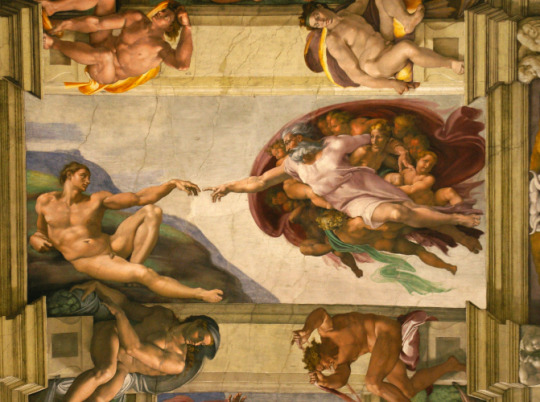

Renaissance furniture was influenced by the Classical World (Ancient Greece and Rome). The design had a strong architectural sense. During this time, having a furniture like this bed (below) was seen as a symbol of social status. Items like beds were an important symbol of wealth because they were expensive, and only the richest families could afford to have them. Canopy beds with four pillars became popular among the wealthy.


Oriental Influenced Style
Oriental, or Asian design often commonly refers to styles from China and Japan, though it also includes styles from Thailand, Korea, Vietnam and other Eastern countries. Oriental design is rich in history and tradition. The design often varies from sleek-styled furniture with low profiles, the nature inspired elements that create a zen calm in the space, to rooms filled with the vibrant, rich colors found in Chinese lanterns, oriental rugs, or silk.


The China set is a popular dinnerware that is known for its elegance, elaborate design, and long history. The first china, or porcelain ware, was created in the Shang Dynasty (16th - 11th century B.C.) for the first time. China is made from kaolin, a fine white clay that is made from decomposing granite. It was in China that the procedures for mixing, molding and firing such items was developed. The making of blue and white Chinese Porcelain started in China by the time of the Mongolian invasion, in the mid-thirteenth century.
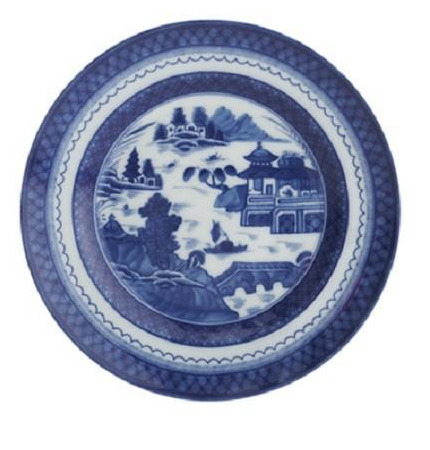
In speaking of China set, I own a China set that I bought years ago that is similar to the picture that is posted above. This is quite opposite to the design of my kitchen as it is more of a modern look with granite counter tops and gray cabinets. The China set is usually put away and only use during special occasions.

When I look around my home, I don’t really see anything that resembles these design periods. My husband and I recently moved into our home about a month ago. Therefore, interior designing the house is still a working progress. However, I see myself decorating my home in a Romantic style. I would like to decorate the interior of my house to feel romantic, elegant, warm, calm, and most of all comfortable. I would like to use soft, neutral tones or pastel colors. The pictures below are several of my decorating inspirations.


0 notes
Text
Task 1 - Specialist Field
What is your specialist field? My specialist field is graphic design and traditional artwork.
Are there common materials and techniques involved in the practice of this specialism? Within graphic design, common materials involve a computer, digital photo software (such as Photoshop, GIMP, or CorelDraw), digital screentones, textures, and fonts, a graphics tablet and pen, PANTONE colour guides, a sketchbook, and an iPad or digital tablet.
Common techniques in graphic design include gradients, colour theory and harmony, typography, digital image manipulation, halftone printing, hierarchy, contrast, negative space, and double exposure.
Within traditional artwork, common materials involve pencils, graphite, and charcoal, coloured & watercolour pencils, blue sketching pencils, dry & oil pastels, ink, oil paints, watercolour paints, acrylic paints, gouache paints, markers, rubbing alcohol, paintbrushes, rulers, rubbers, and a sketchbook of good quality.
Common techniques in traditional artwork involve drawing, painting, sculpture, printmaking, glass painting, fresco, action painting, shading, crosshatching, contouring, light sources, use of screentones, perspective, and monochromatic colour.
The two can often cross over in terms of techniques and materials - for example, a lot of digital painting software offers traditional art techniques and digital brushes, while light sources and monochromatic colour are just as important for graphic design.
How long has this specialism been practiced? Does it have a history and can we trace the development of this specialism through the research of key individuals?
Traditional art has been practiced since humans learned how to express themselves artistically, beginning with cave paintings in 30,000 B.C. to 2500 B.C.
During the Egyptian period, art was created using clays, minerals, and charcoal as paint and papyrus and reeds for brushes - the Egyptians pioneered hieroglyphics as text, a very early form of a picture book.
Chinese and Japanese art during the 1800s focused on recreating themes from classical literature, nature, and spiritualism, as well as pioneering woodblock printing. The Great Wave off Kanagawa by Katsushika Hokusai is probably the most well-known Japanese traditional painting from the 1800s.
The Middle Ages saw the beginning of Celtic, Gothic, and Romanesque art, influencing much modern art.
The Renaissance era gave us some of the most well-known names in classical art - Michelangelo, Donatello, and Botticelli - and some of the most well-known art pieces of all time. Renaissance art has influenced everything from fashion to music.
Later into modern history, art styles such as cubism, constructivism, dadaism, and abstract expressionism began to form from the beginning of the 1900s onwards. The late 1900s saw pop art and postmodernism begin to take hold.
Graphic design initially began in the Renaissance and industrial era. With the invention of the printing press, humanity could recreate text on a mass scale, and with that came the desire for fonts. Modern companies took notes on how aesthetics could influence consumer habits.
The printing industry began using logos in the 1400s. This was important as how well your logo was printed reflected on how well everything was printed.
The first print advertisements began to appear in the mid-1600s. One of the earliest known advertisements is for a horse and cart renting service.
The mid-1800s bought chromolithography into printing, due to the advancement of technology. This allowed prints to be detailed, sharp, and in colour. It also enabled realism in images.
The first graphic design agency - Austria’s Wiener Werkstätte - appeared in 1903. It was an organization of painters, artists, and early graphic designers, and provided a roadmap for other collaborative agencies to follow.
Bauhaus, possibly the most famous name in graphic design, opened its doors in Germany in 1919. It provided a schooling to future influencers of graphic design and modern art movements.
From the 1950s onwards, the digital era slowly rose to prominence. Adobe Photoshop was first launched in 1990, and changed the face of graphic design forever. Networks such as MTV bought a new take on logos with every ad bumper, constantly changing their design while still maintaining recognisable characteristics.
How is your specialism practiced today?
Traditional art is still practiced worldwide, most commonly in sketching. Comic books are the biggest commercial form of traditional art, as well as manga and anime. Painting eras such as Baroque and Romanticism have came back in popularity, with painters such as Roberto Ferri drawing on them highly as sources of inspiration. Drawing challenges such as ‘Inktober’ provide an opportunity for artists to stretch their traditional muscles, with the artist having to draw a traditional sketch every day throughout the month of October. Street art has also became popular as an art form, with graffiti artists like Banksy fetching high prices for their pieces.
Digital art is incredibly common amongst young people, most likely due to the mass and easy access of design apps and software. Vaporwave, surrealism, pop art, glitch art, minimalism, collages, photo comics (such as A Softer World), and typography are all modern forms of digital art. Websites and companies such as VICE and Thrasher all promote a minimal, clean aesthetic with focus on sans-serif text, monochromatic colours, and inspiration from street art.
Research a number of specialists in this field today/people who influence you
Name: Aubrey Beardsley
Born: 21 August 1872 – 16 March 1898
Nationality: English
Profession: Illustrator, author
Biography: Born in Brighton, England, Beardsley’s first cartoons and illustrations appeared in his grammar school’s magazine. He attended Westminster School of Art in 1892, before travelling to Paris where he discovered the poster art of Henri de Toulouse-Lautrec, and the Parisian fashion for Japanese prints. Both became major influences on his style. Beardsley became controversial in the art world for his images detailing erotica and dark aesthetics. He died of tuberculosis in 1898.
Art style: Art Nouveau, aestheticism. His illustrations were mostly in stark black and white, created through the use of ink and paintbrushes.
Notable pieces: The Peacock Skirt (1893), The Black Skirt (1894-5), The Dancers Reward (1891), The Barge (1896), Isolde (1899)
Name: Roberto Ferri
Born: 1978
Nationality: Italian
Profession: Artist, painter
Biography: Ferri was born in Taranto, Italy. In 1996, he graduated from the Liceo Artistico Lisippo Taranto, a local art school in his hometown. He moved to Rome in 1999, and began to study painting on his own. He displayed a strong interest in painting beginning at the end of the 16th century, in particular. he graduated with honours from the Academy of Fine Arts in Rome in 2006.
Art style: Romanticism, Symbolism, Baroque art
Notable pieces: Fallen Angel (2011), Il Canto Della Vergine (2015), Lucifer (2013), Redemption (2011), The Marriage of Heaven and Hellway (2011), Achille (2017)
Name: Andy Warhol
Born: August 6, 1928 – February 22, 1987
Nationality: American
Profession: Artist, photographer, printmaker, director
Biography: Warhol was born in Pennsylvania. In the third grade, he developed a complication of scarlet fever, and while confined to bed, drew, listened to the radio, and collected images of movie stars. He won a Scholastic Art and Writing Award as a teen, and studied commercial art at the Carnegie Institute of Technology. After earning a Bachelor of Fine Arts in pictorial design in 1949, he moved to New York City and began a career in magazine illustration and advertising. He was an early adopter of the silk screen printing process and used this to develop his ‘blotted line’ technique, applying ink to paper and blotting the ink while it was still wet. During the 1960s, he began to make paintings of iconic American objects such as dollar bills, Campbell's Soup Cans, Coca-Cola bottles, as well as celebrities such as Marilyn Monroe, Marlon Brando, Muhammad Ali, and Elizabeth Taylor. He also made sculptures, movies, and took photographs of personalities such as Edie Sedgwick. He founded “The Factory’, his studio space, and gathered a squad of creatives, bohemian personalities, and underground celebrities. A controversial and renowned artist, he died in 1987 in his sleep due to an irregular heartbeat.
Art style: Pop art, sculpture, film, photography
Notable pieces: Marilyn Diptych (1962), Campbell’s Soup Cans (1962), Green Coca-Cola Bottles (1962), Race Riot (1964), Big Electric Chair (1967)
Name: Jim Fitzpatrick
Born: N/A
Nationality: Irish
Profession: Artist
Biography: Educated at the Franciscan College in Gormanston, County Meath, Jim Fitzpatrick became known for his intricate and detailed artwork inspired by the Irish Celtic tradition. He has produced much artwork for Irish rock band Thin Lizzy, as well as The Darkness and Sinéad O’Connor. However, his most well-known image is ironically the 1968 two-tone portrait of Che Guevara.
Art style: Irish Celtic art
Notable pieces: Che Guevara (1968), Aille the Fair (1975), Chinatown (1980), Black Rose (1979)
Name: Ellen Bernard Thompson Pyle
Born: November 11, 1876 – August 1, 1936
Nationality: American
Profession: Illustrator
Biography: Born in Philadelphia, Pyle began her studies at the Drexel Institute of Art, Science and Industry in 1895. She studied under Howard Pyle in 1897, becoming one of his top students, and was given commissions for periodicals and books. During the 1920s, she began work at the Saturday Evening Post and created 40 covers for the paper under the guidance of the editor-in-chief, George Horace Lorimer. She died in 1936 of heart disease.
Art style: Contemporary art
Notable pieces: Flapper (1922), Woman with Headband (1922), You’ve Come a Long Way Baby (1926), Ermine Muff (1923), Pretty in Pink (1930)
What kind of work flow is followed within your specialism?
In both traditional and graphic art, the work flow and ideas generation process is very simple. First off, the artist will think of an idea and then note it down - this can be in a sketchbook, a notepad, or on Post-It notes. After that comes doodles or a moodboard of what the artist wants to portray - this can be composed of anything, such as photography, existing designs or art, people, fashion, makeup, or even music. It all comes down to whatever strikes the creativity of the artist. After the moodboard is created, the artist will create concept sketches or different ‘rough’ versions of their idea. They will then use these sketches to formulate their final idea.
This video shows a typical art workflow for a company logo, as given by Aaron Draplin:
youtube
0 notes